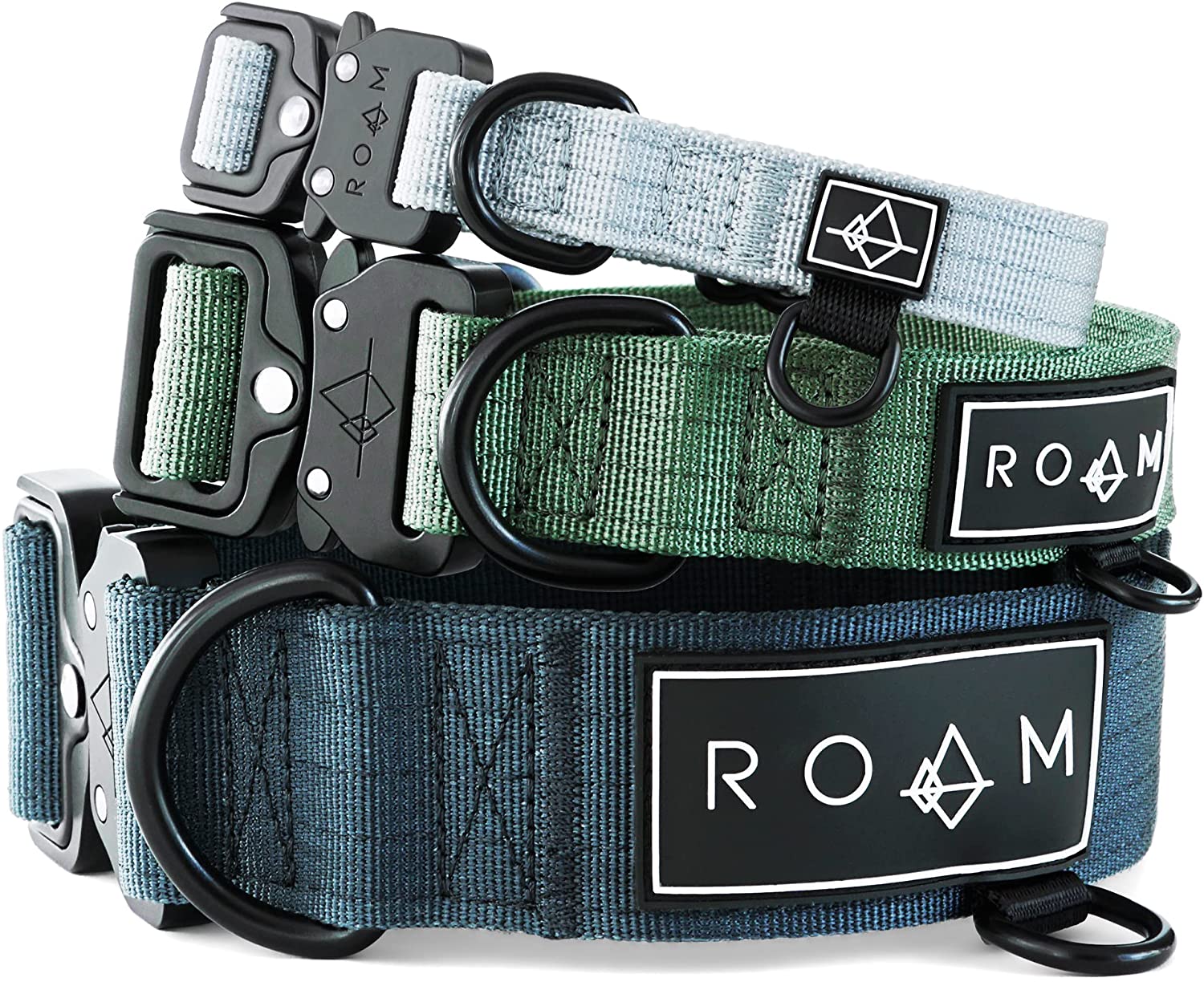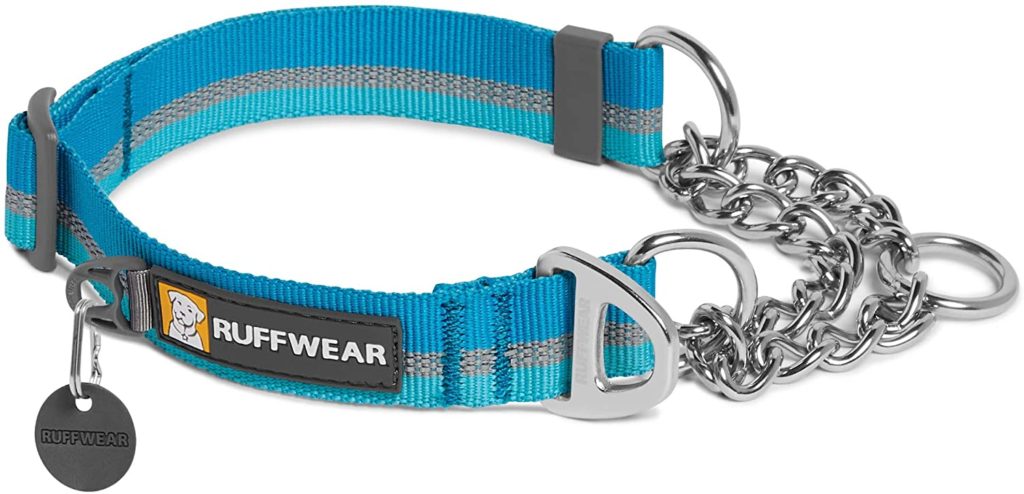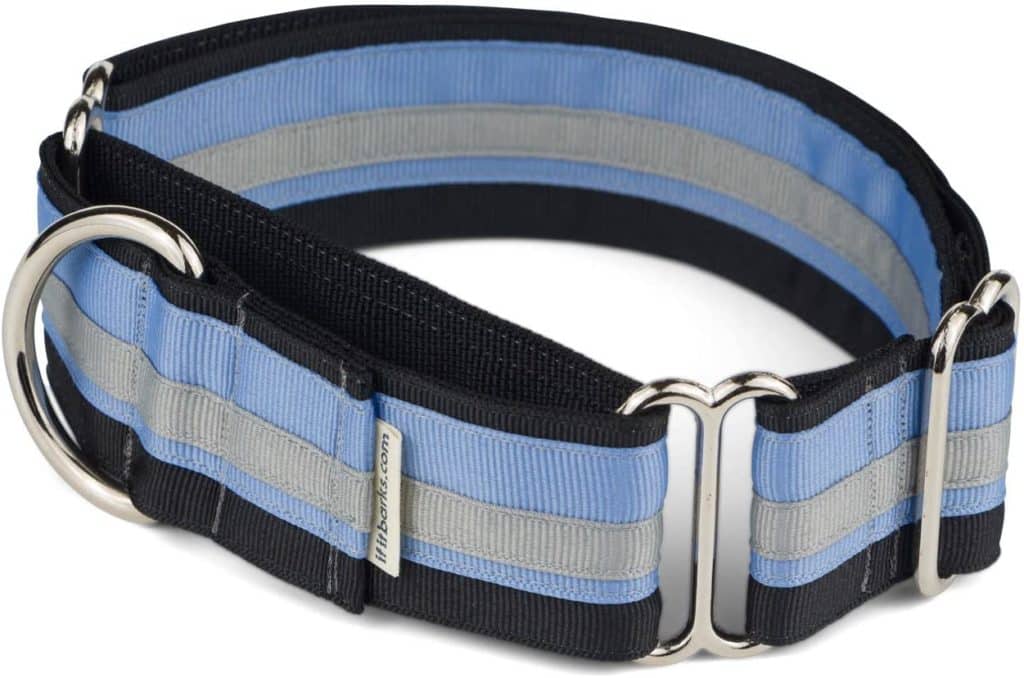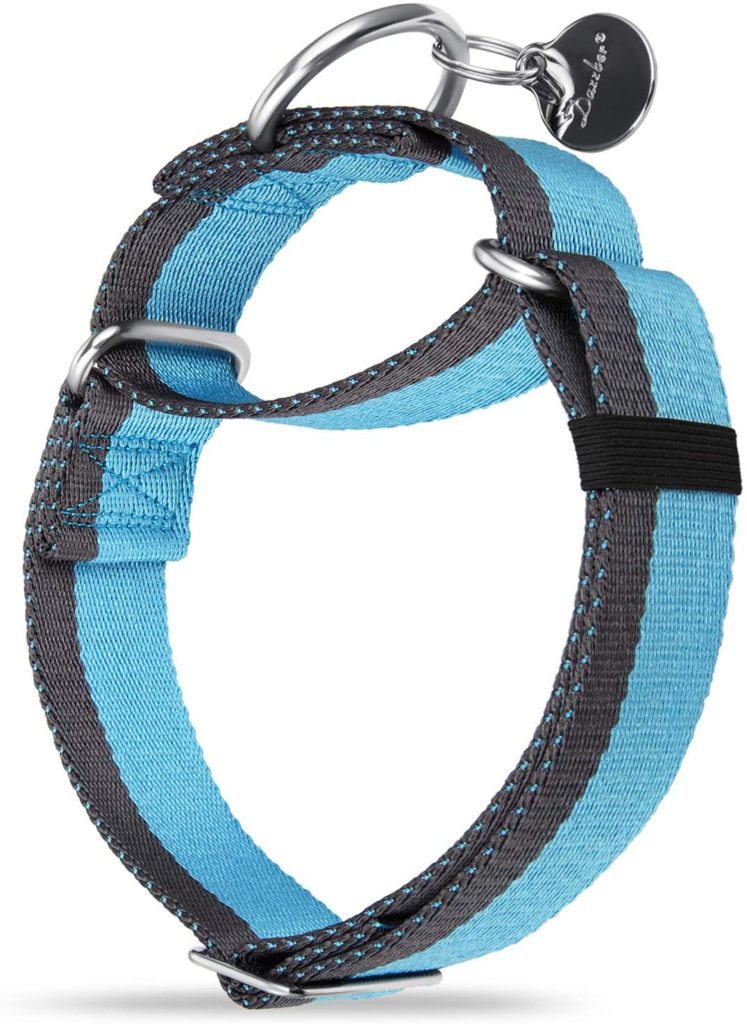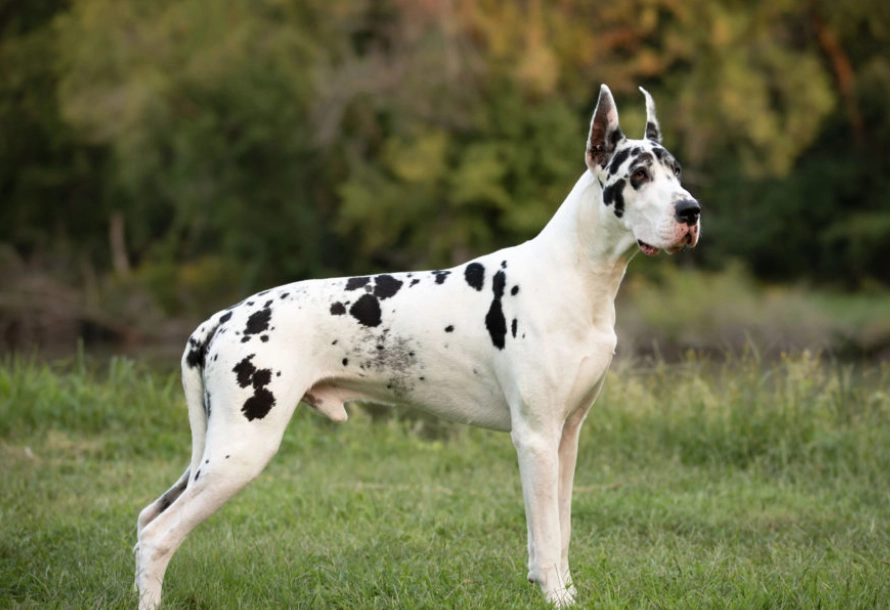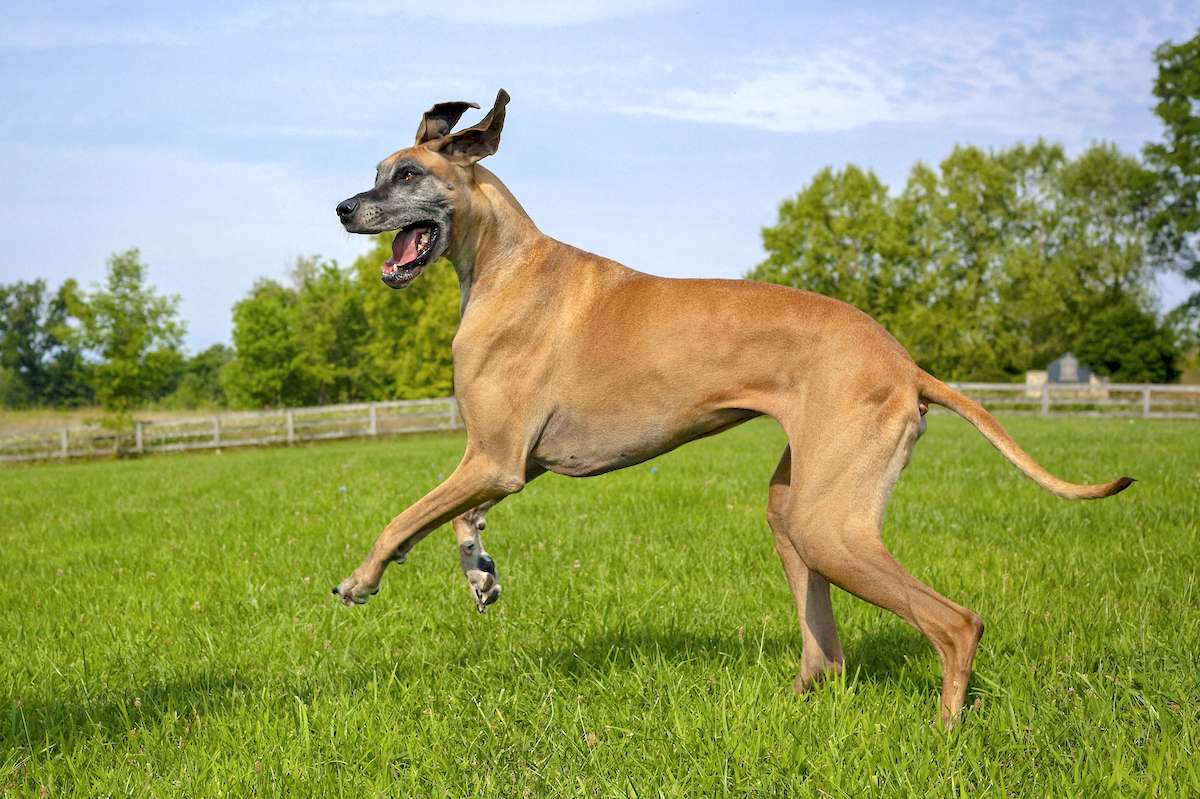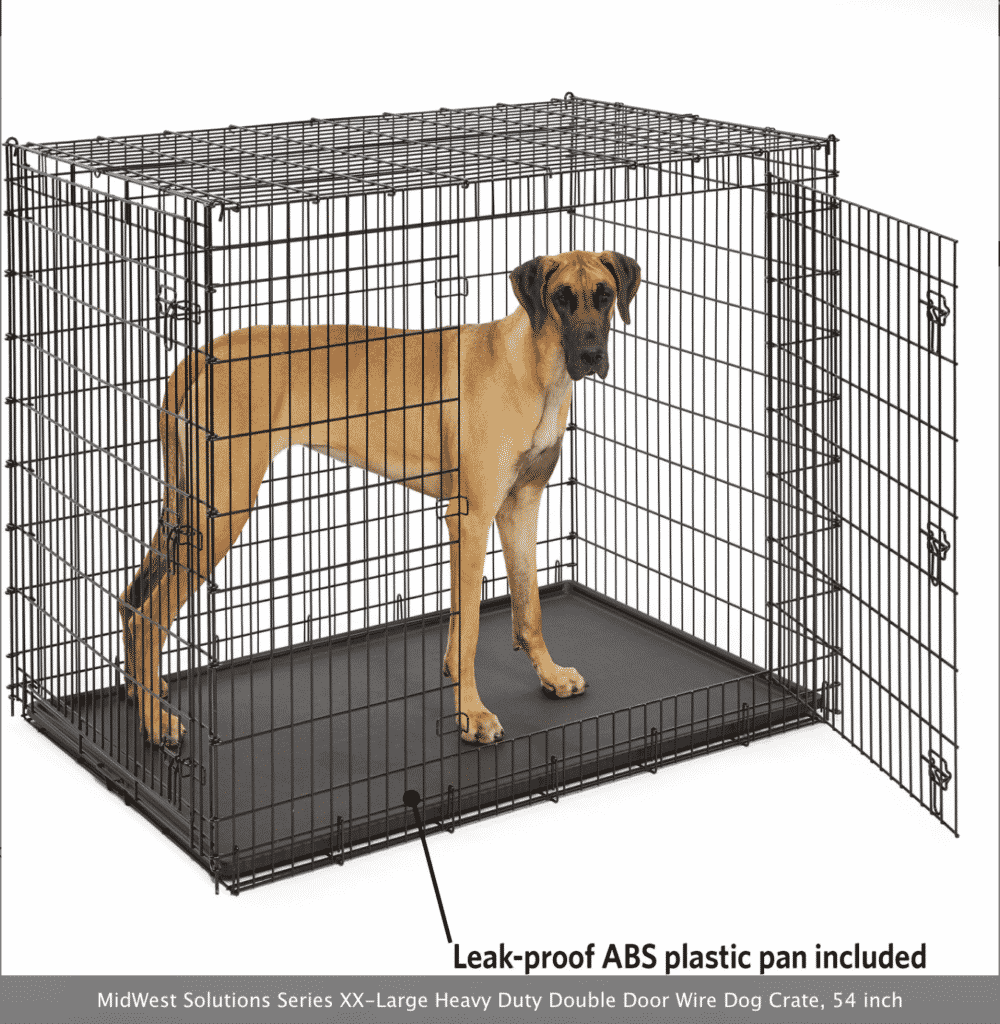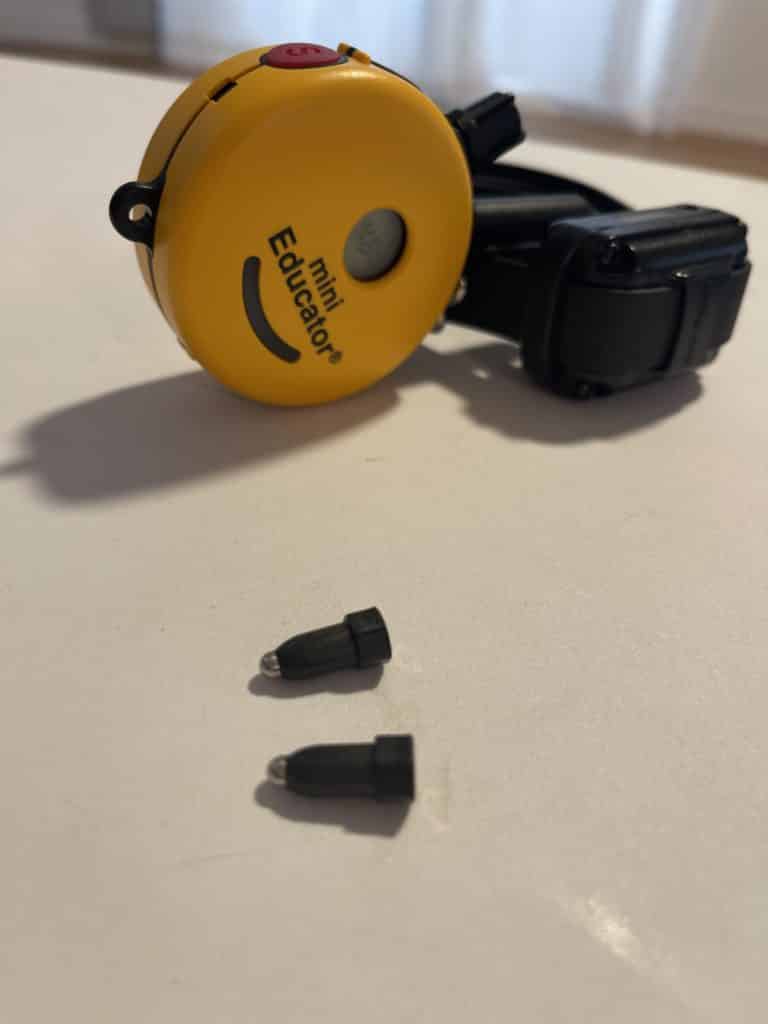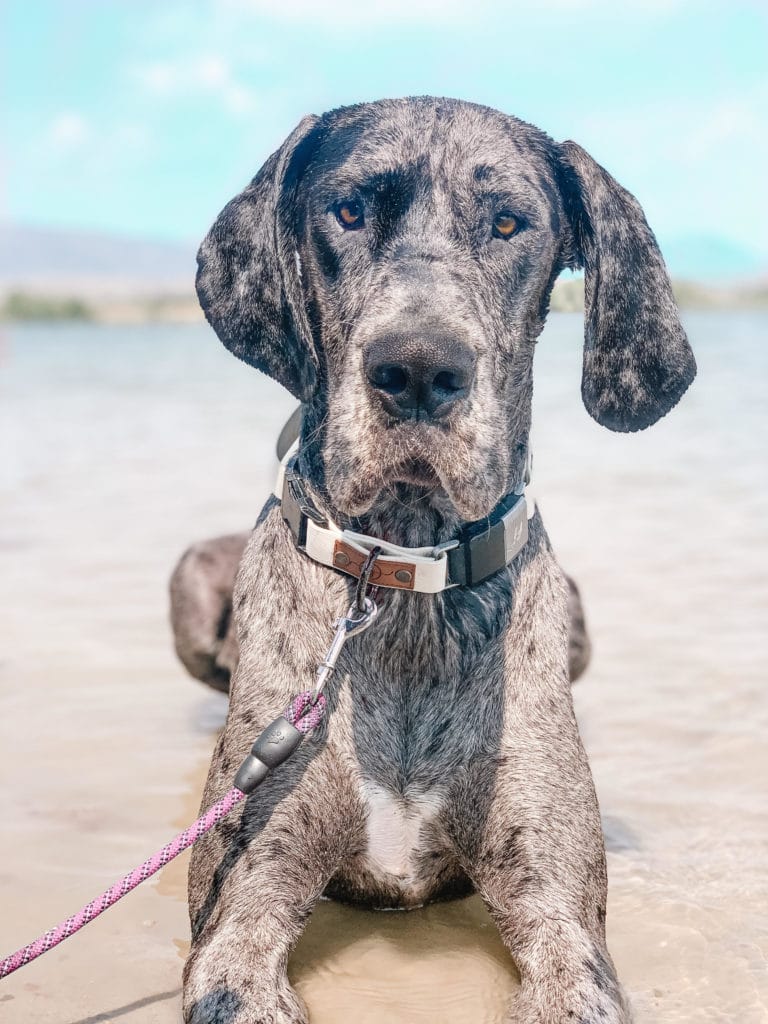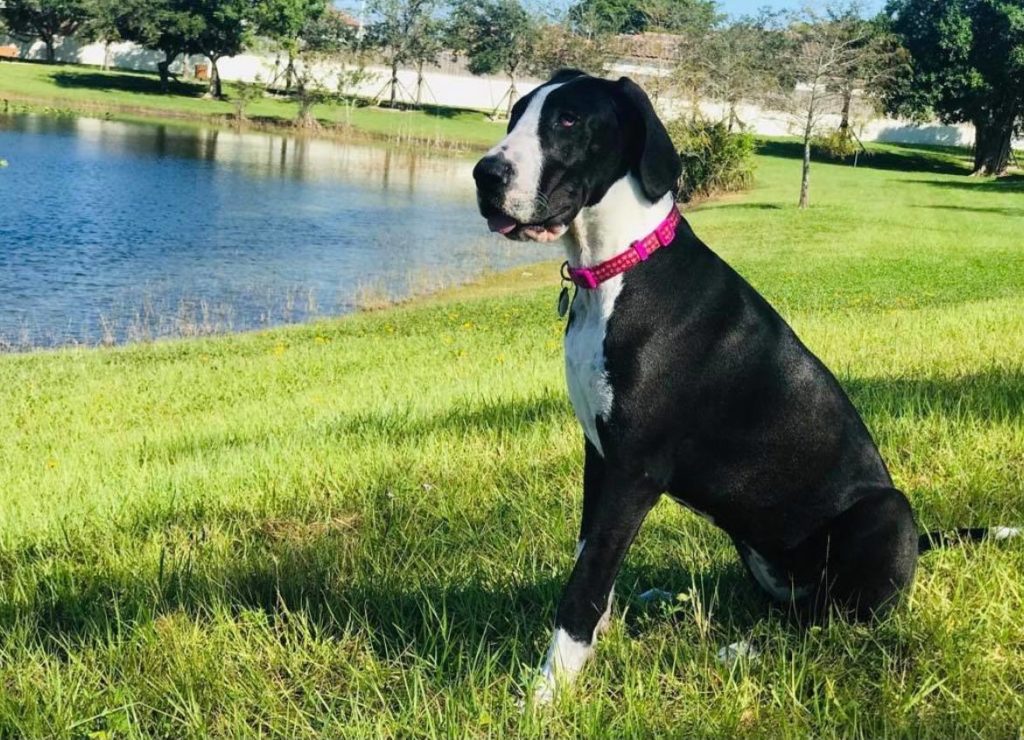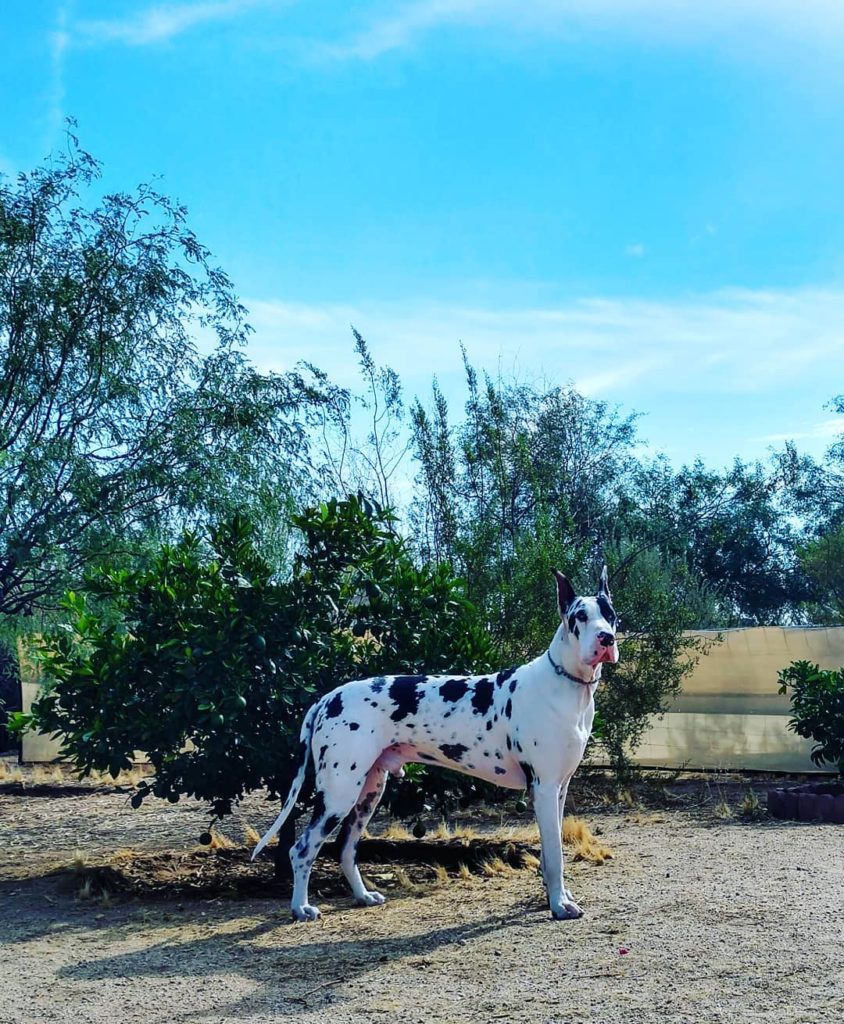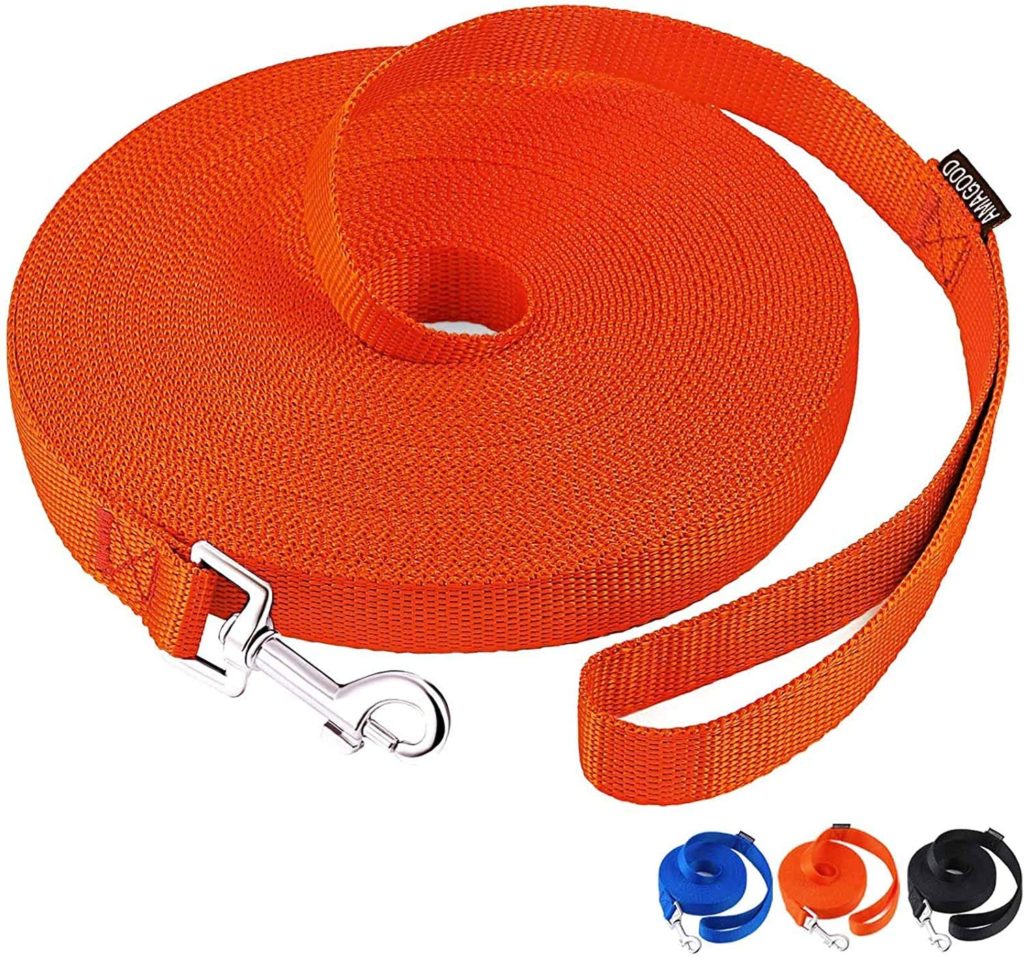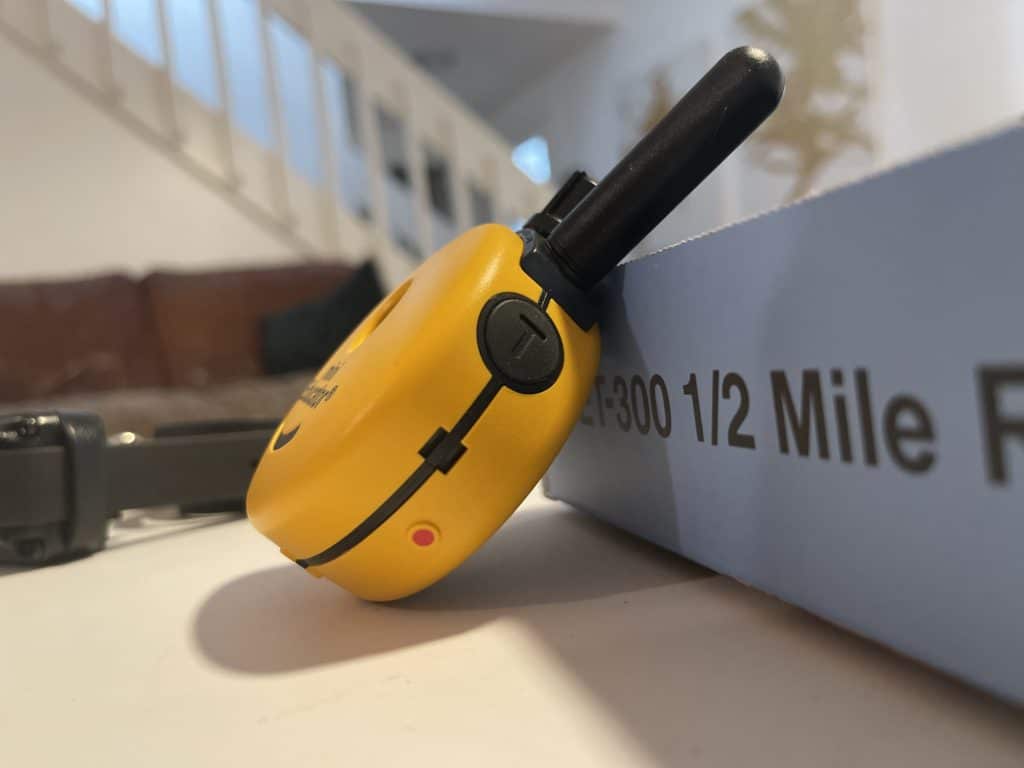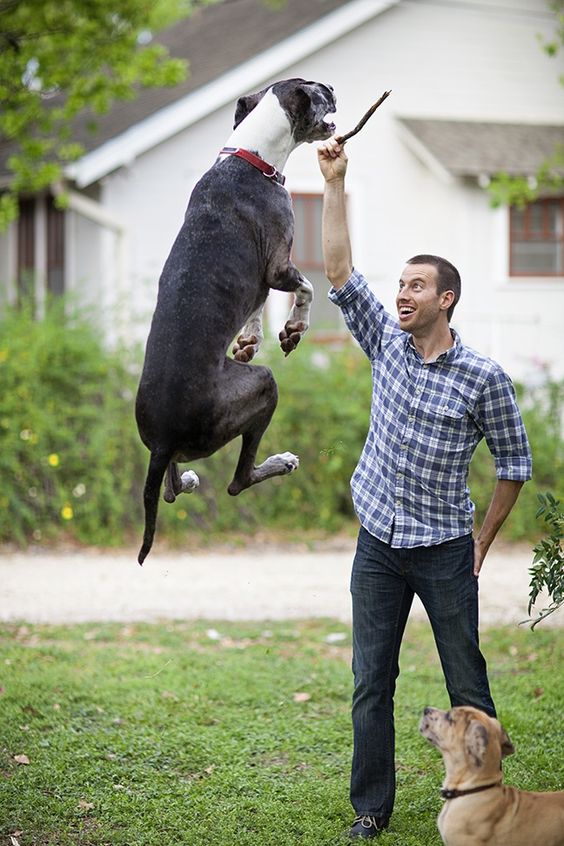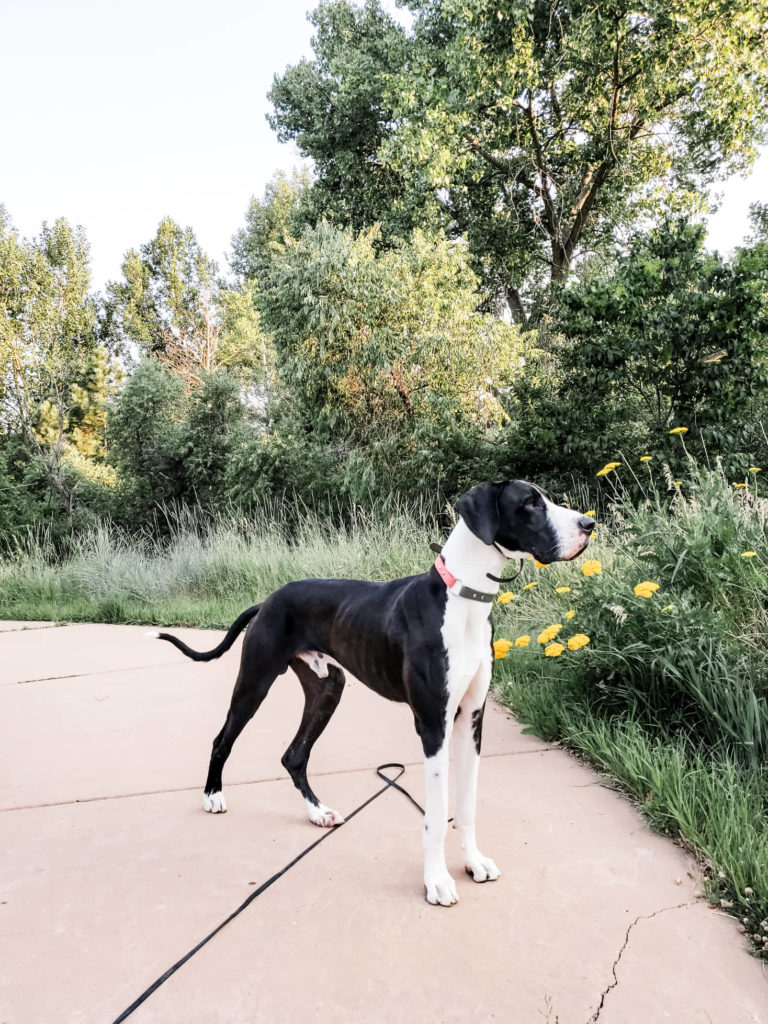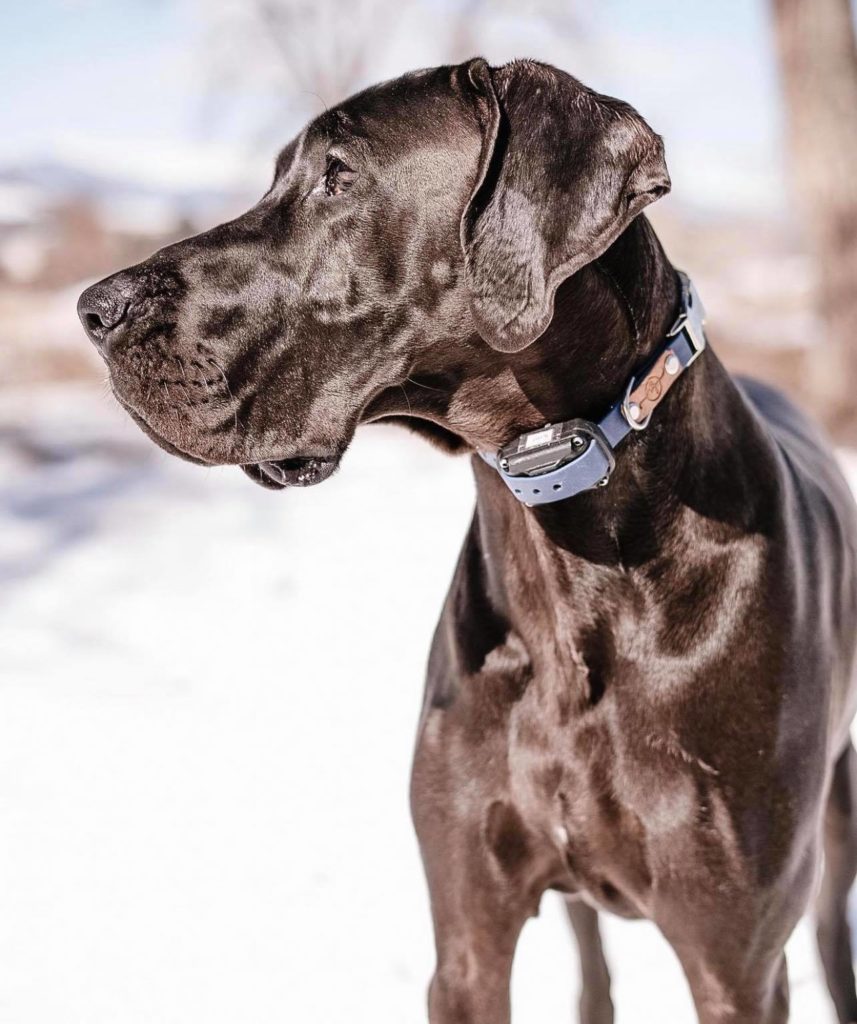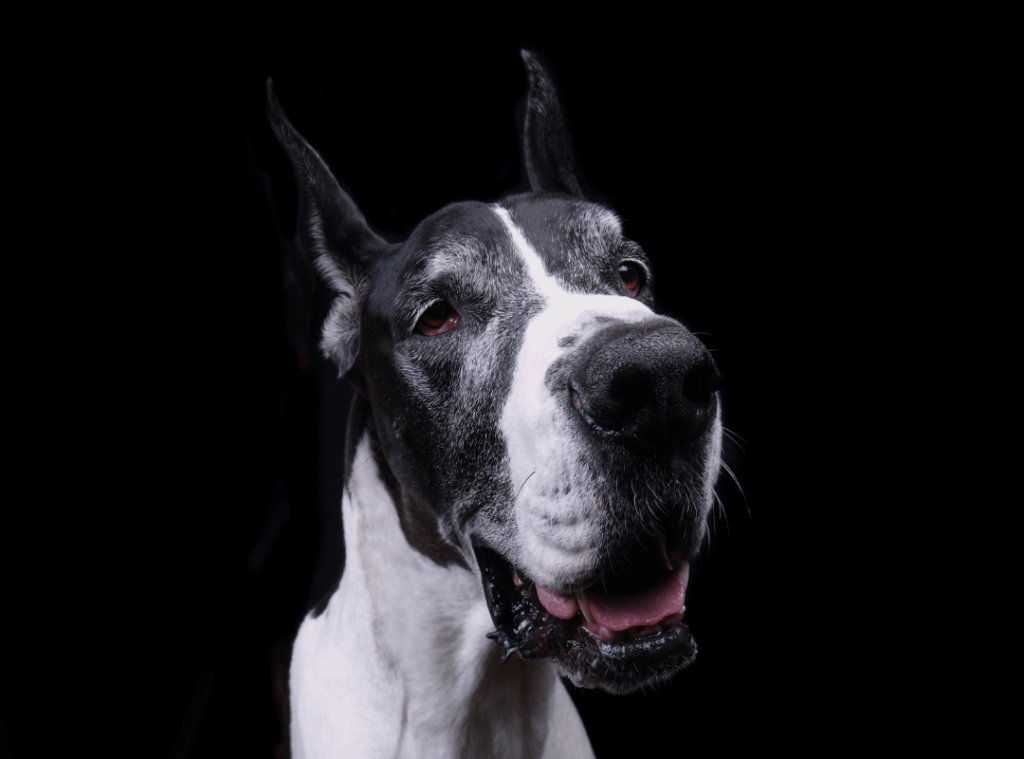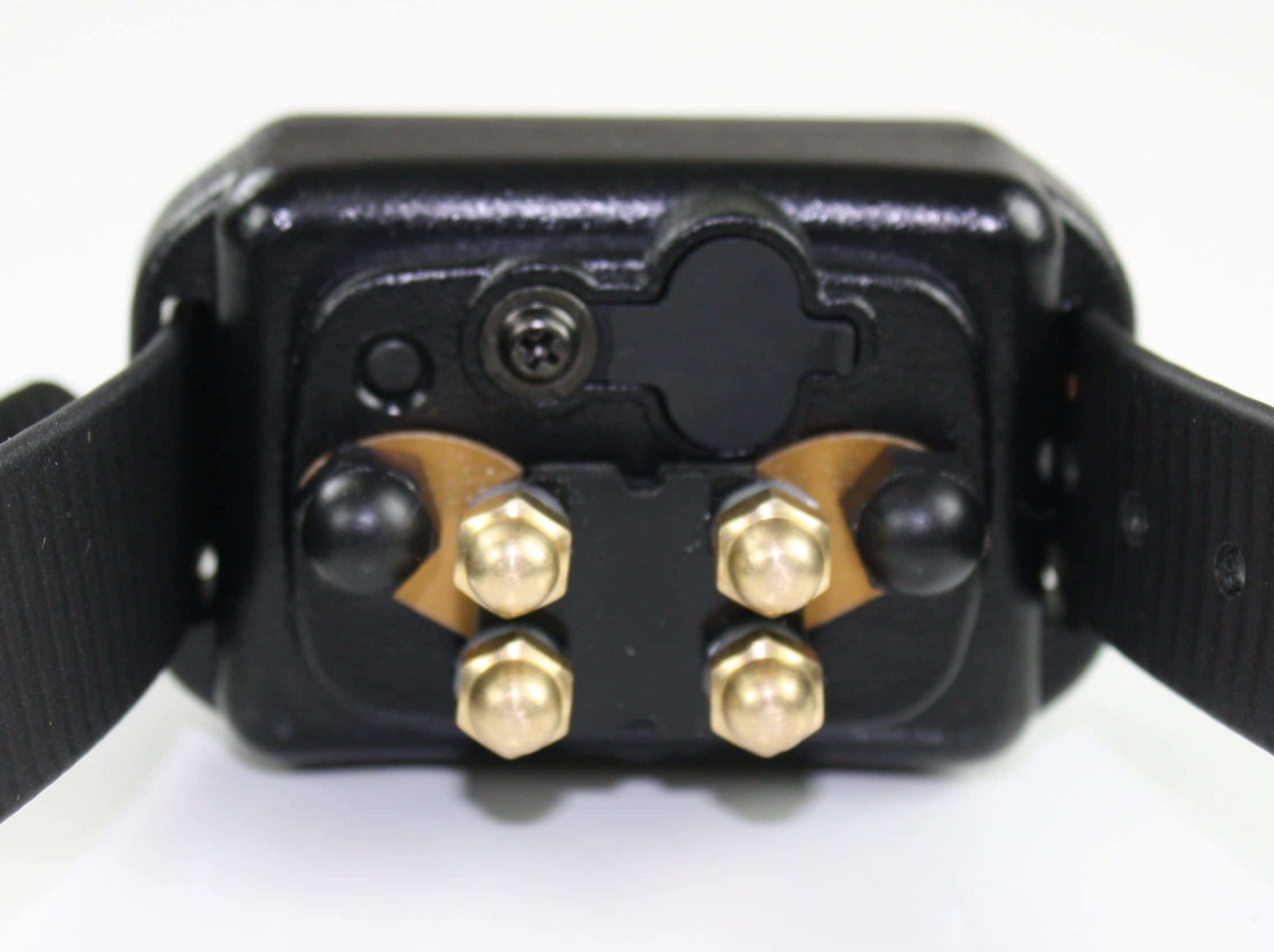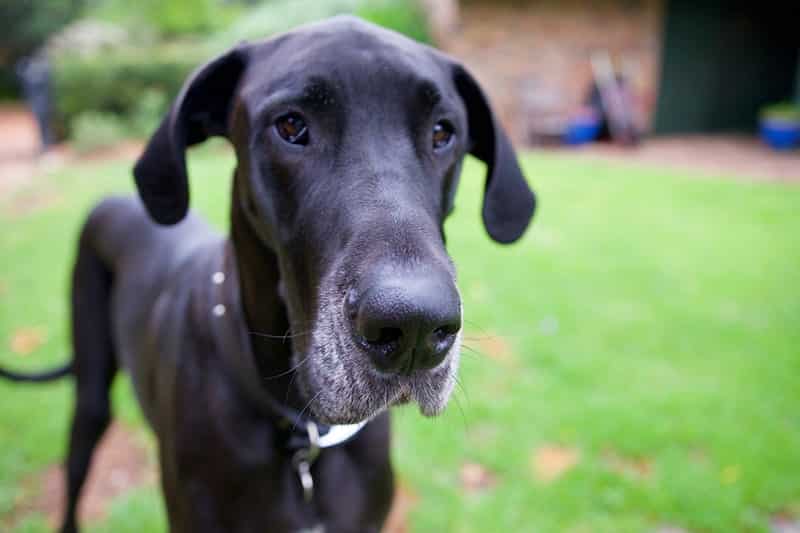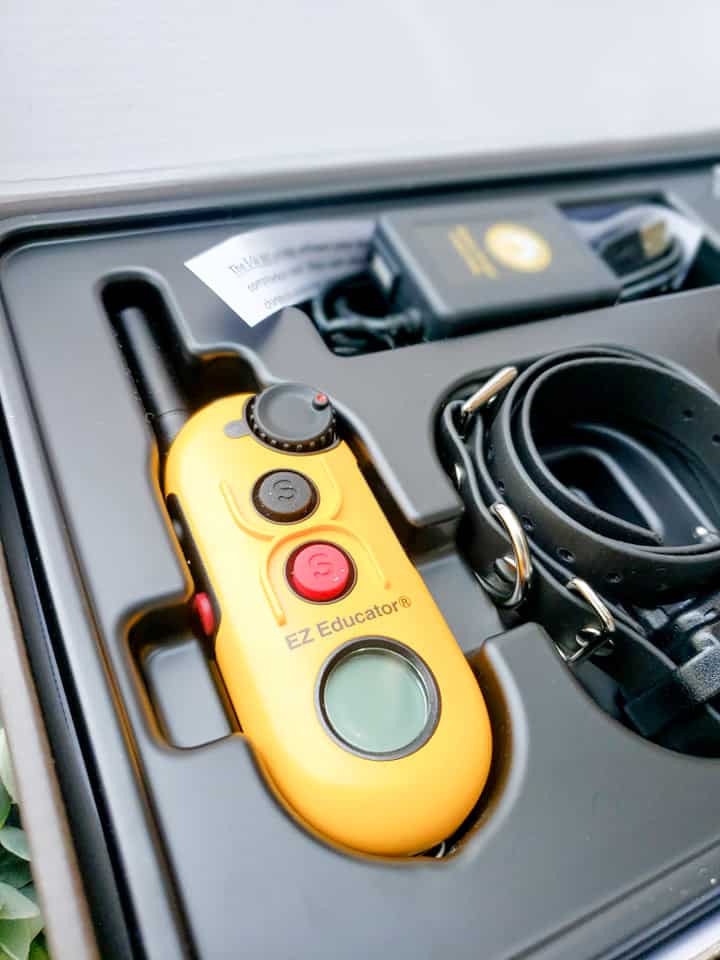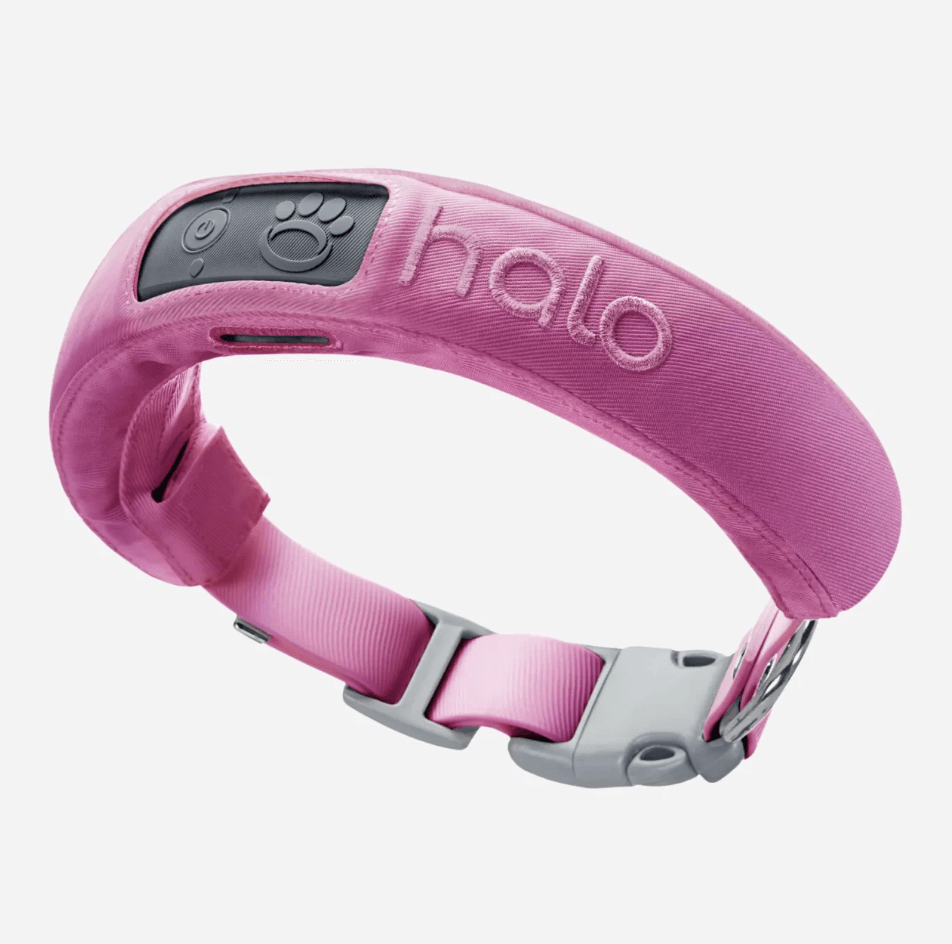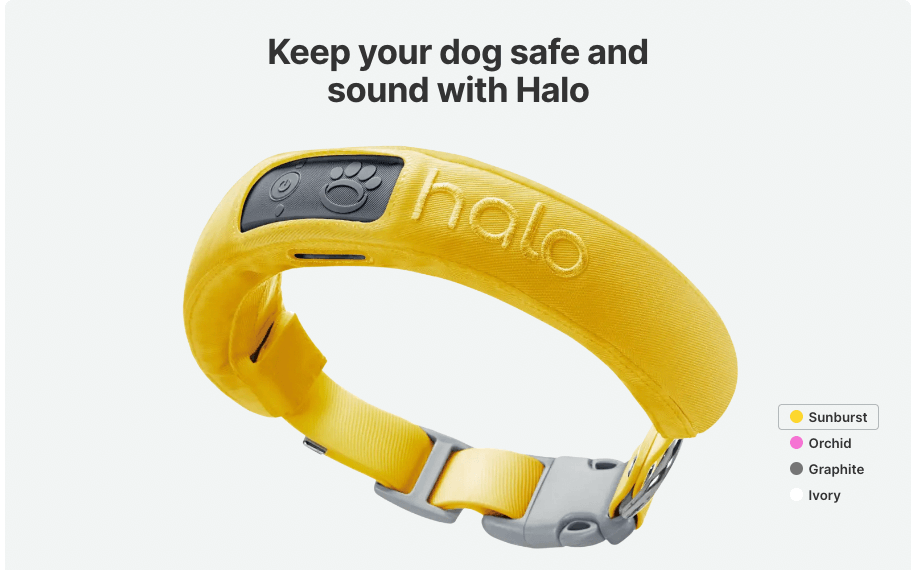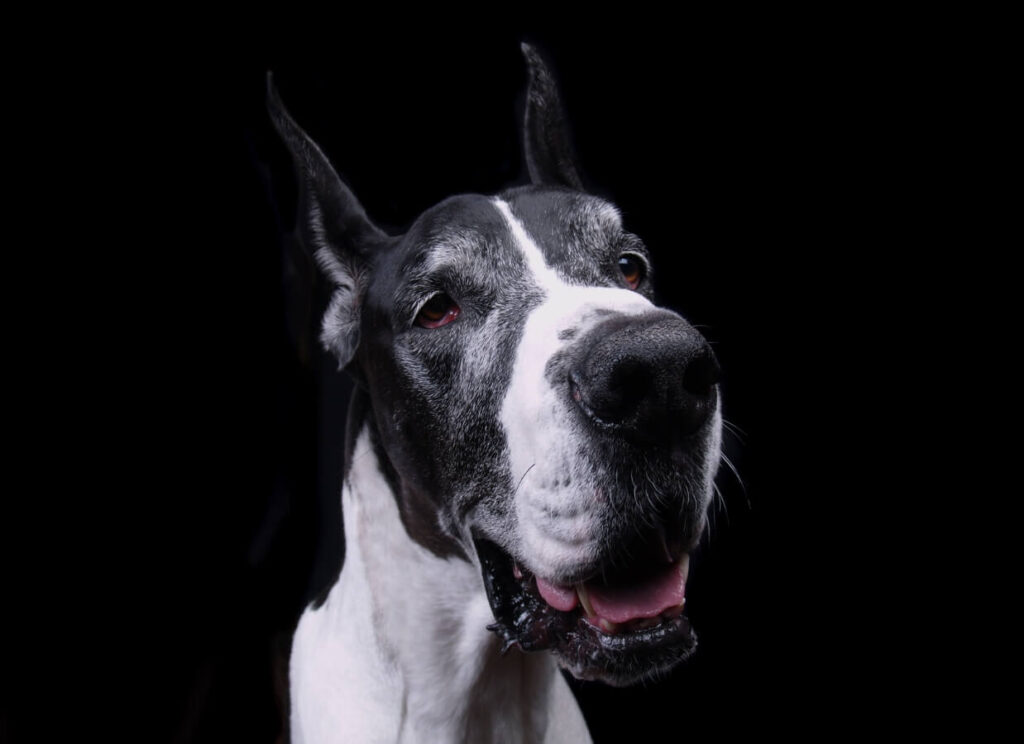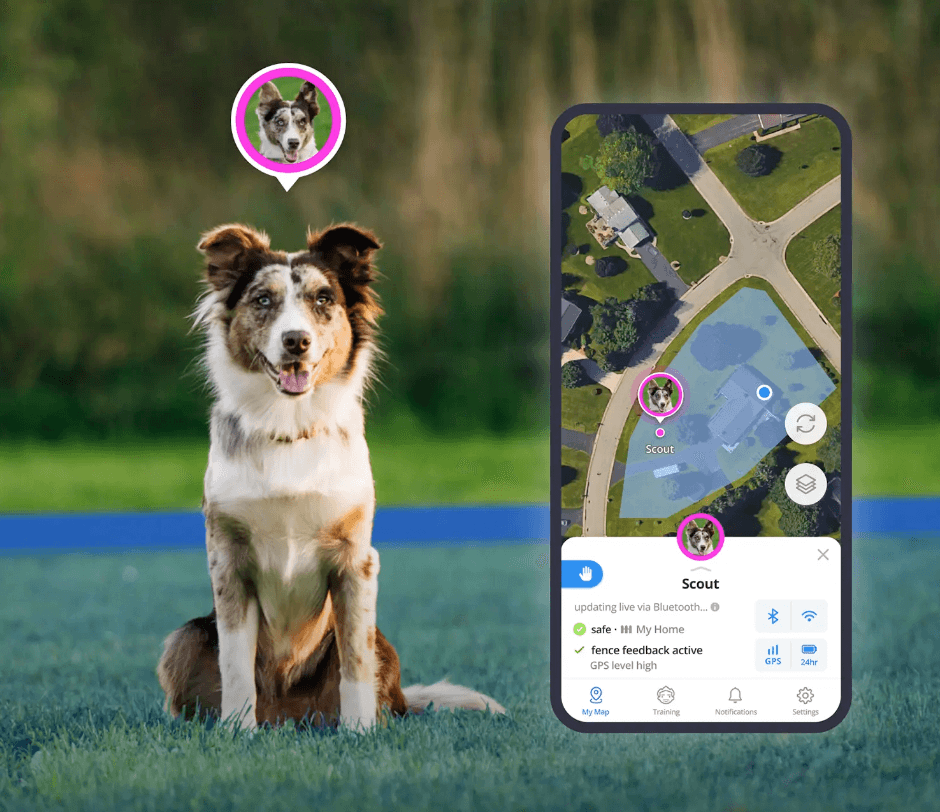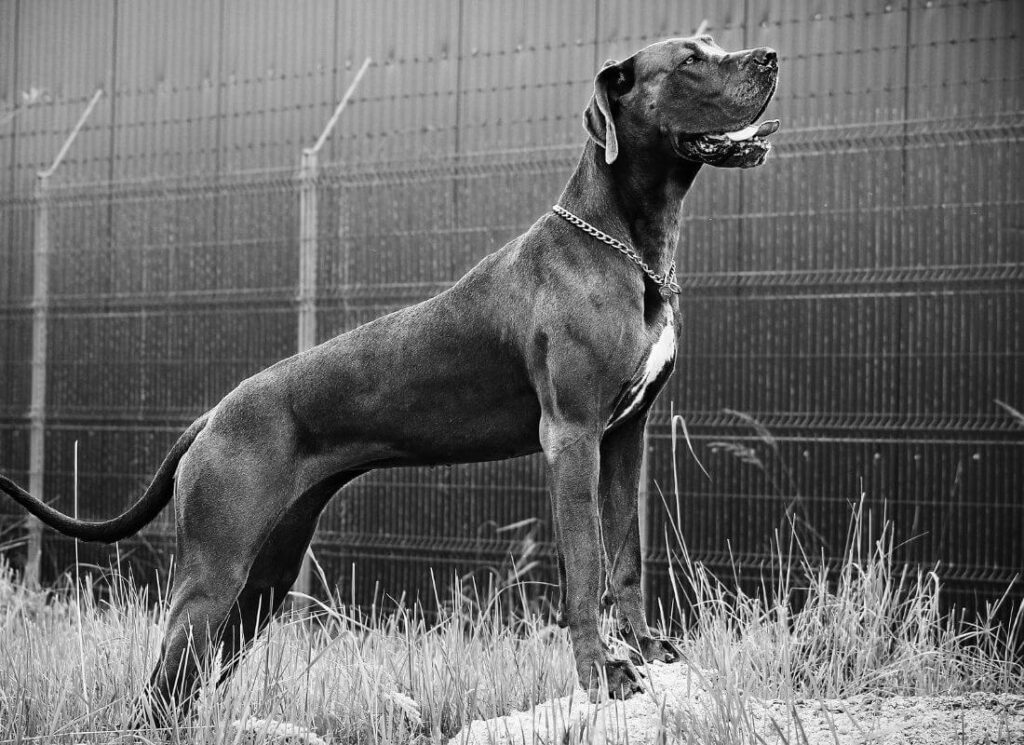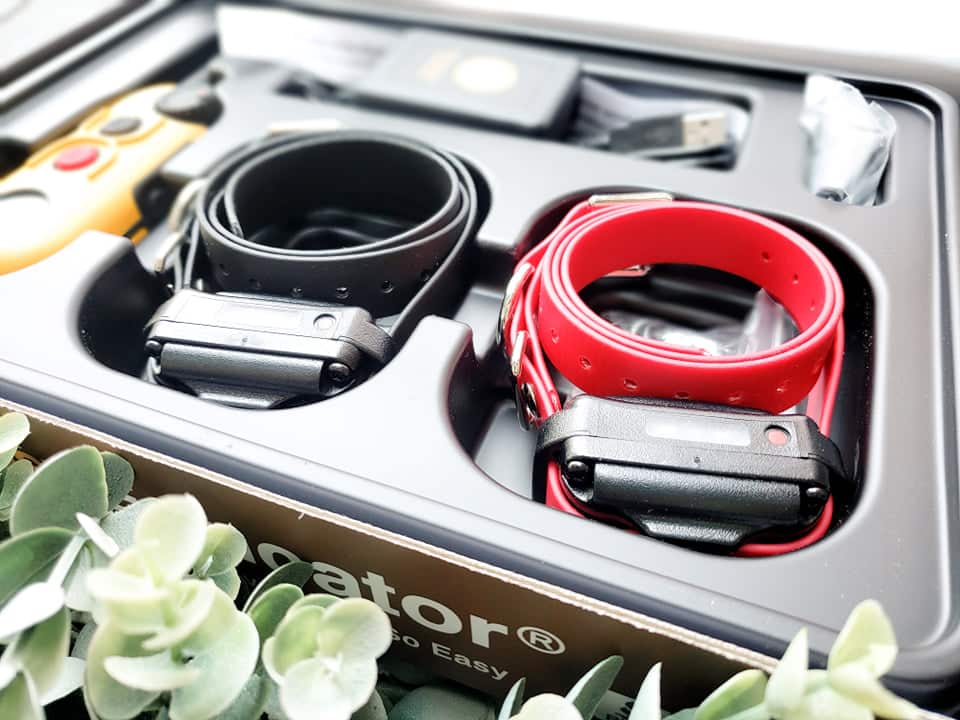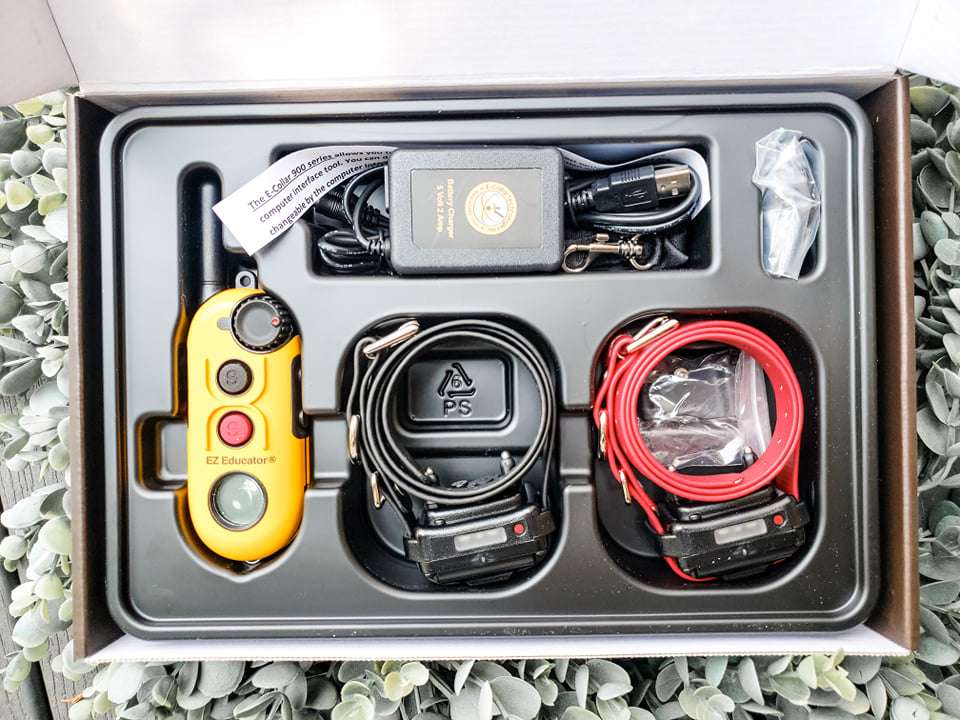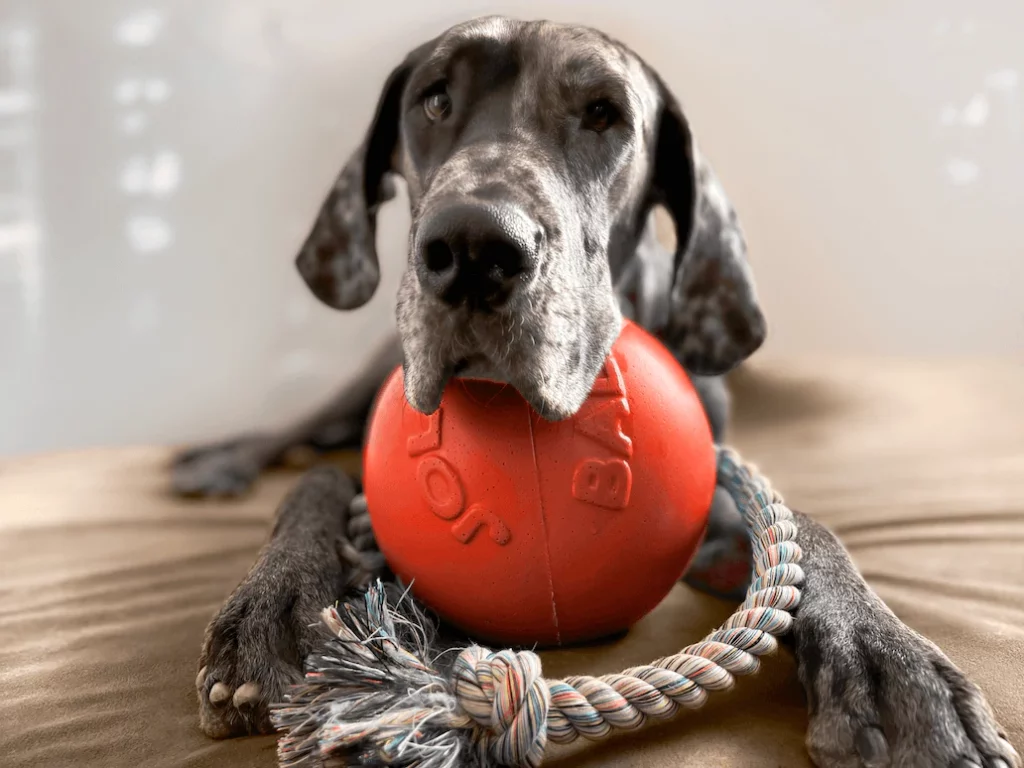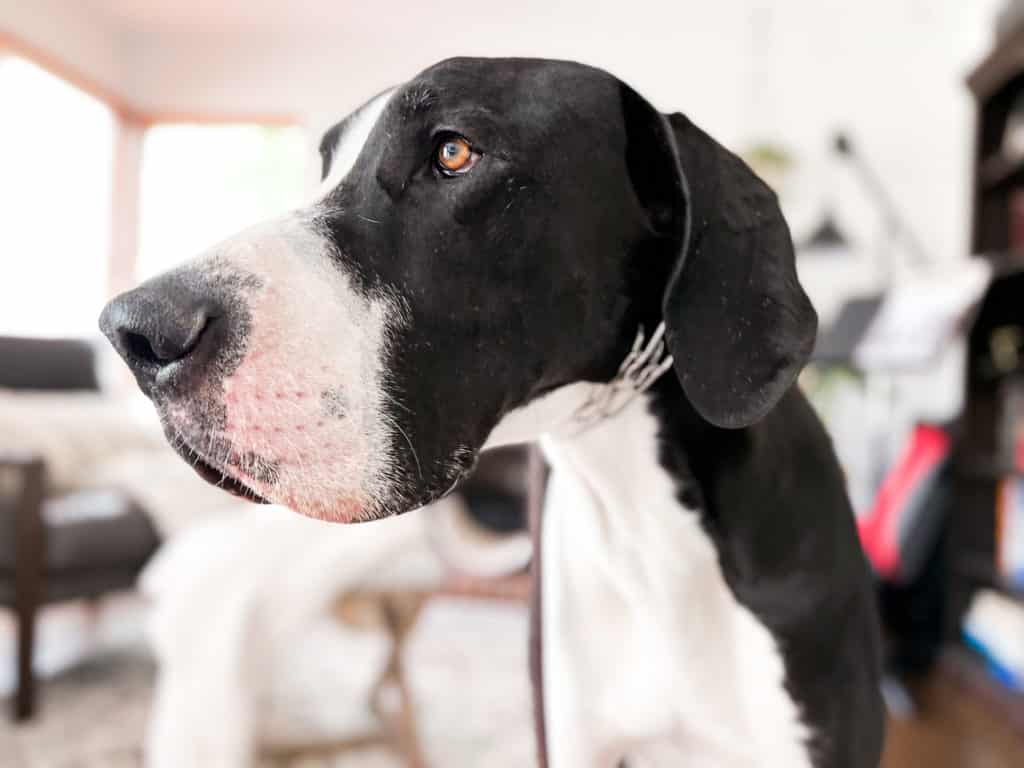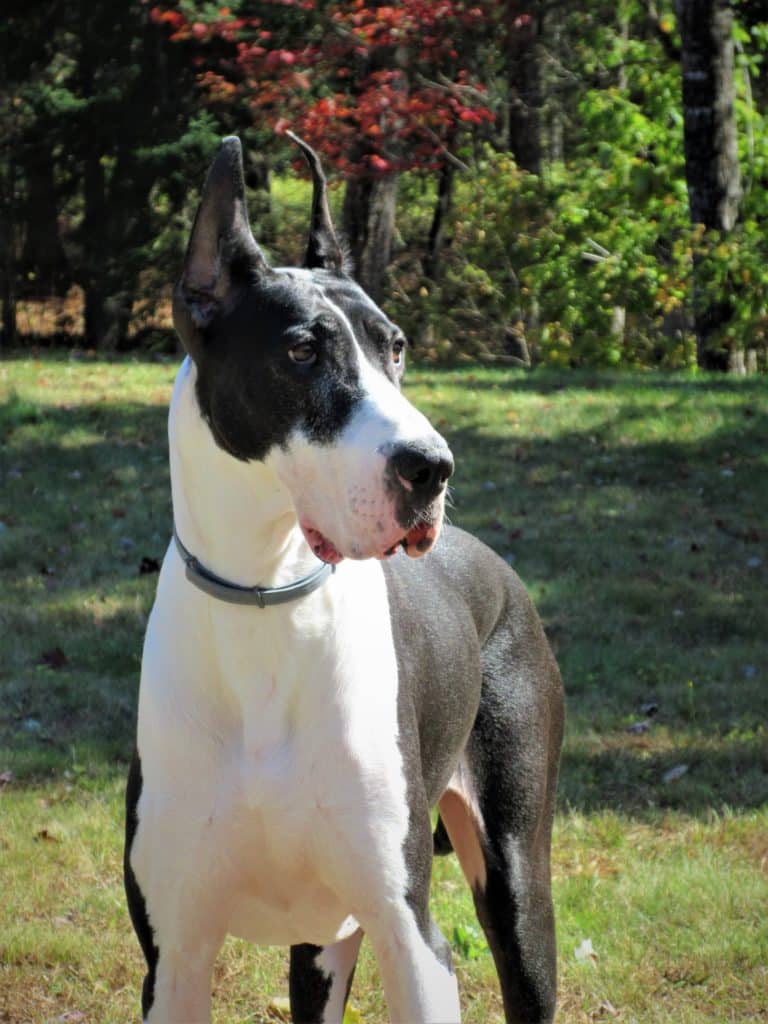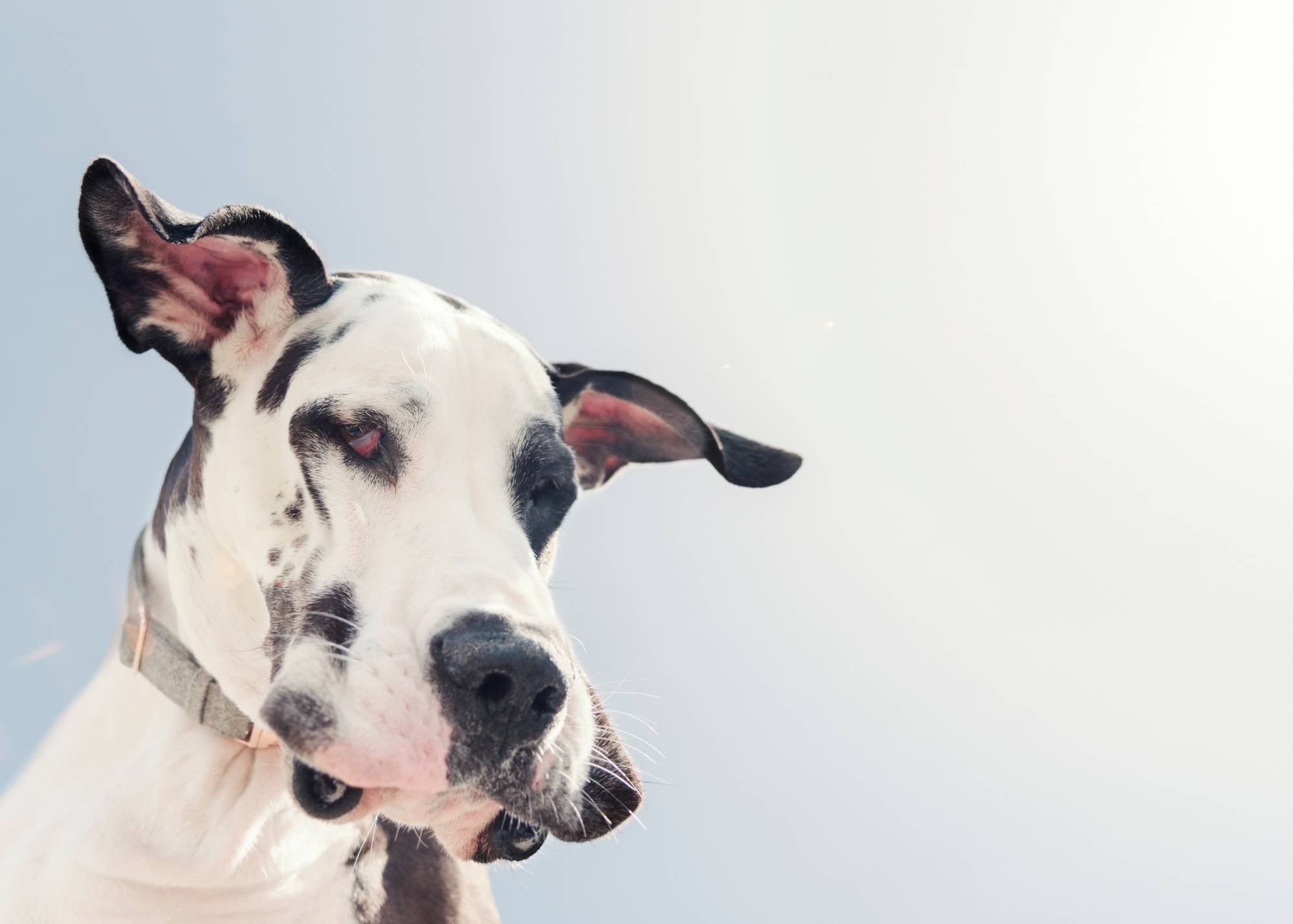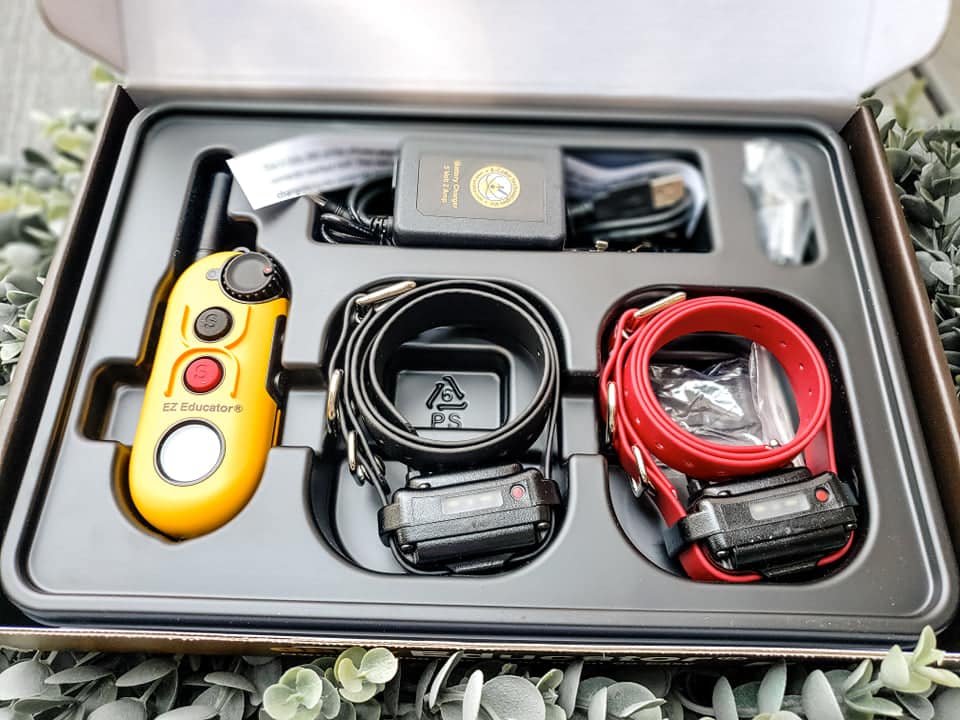When it comes to choosing the best collars for Great Danes, we’ve got you covered! There are many different types of dog collars available for puppies or adults on the market today, from traditional buckle dog collars to harnesses, electric collars, and beyond.

So, which one should you choose?
Do you have a puppy? Does your dog pull? Do you have problems with running away, fence-jumping, lunging, or escaping? We’re sharing tons of information, and more, below.
Should a Great Dane Wear a Collar or a Harness?

A very small but notable study was done showing that harnesses, even the type that is meant to be ‘non-obstructive’ nearly always change the way that a dog moves and walks. This is something that has been theorized for many years.
More studies are needed but as owners of giant breed dogs, we should all take note!
While harnesses have their place, we believe that in general off-leash obedience and wide, flat collars are much better than harnesses for Great Dane’s orthopedic health and for Great Dane owners.
Collars are safer, less restrictive, and more humane overall for most dogs, especially when paired with positive training that will ultimately give you full voice control of your dog.
For more information on each type of harness that you might choose for a Great Dane, check the table of contents.
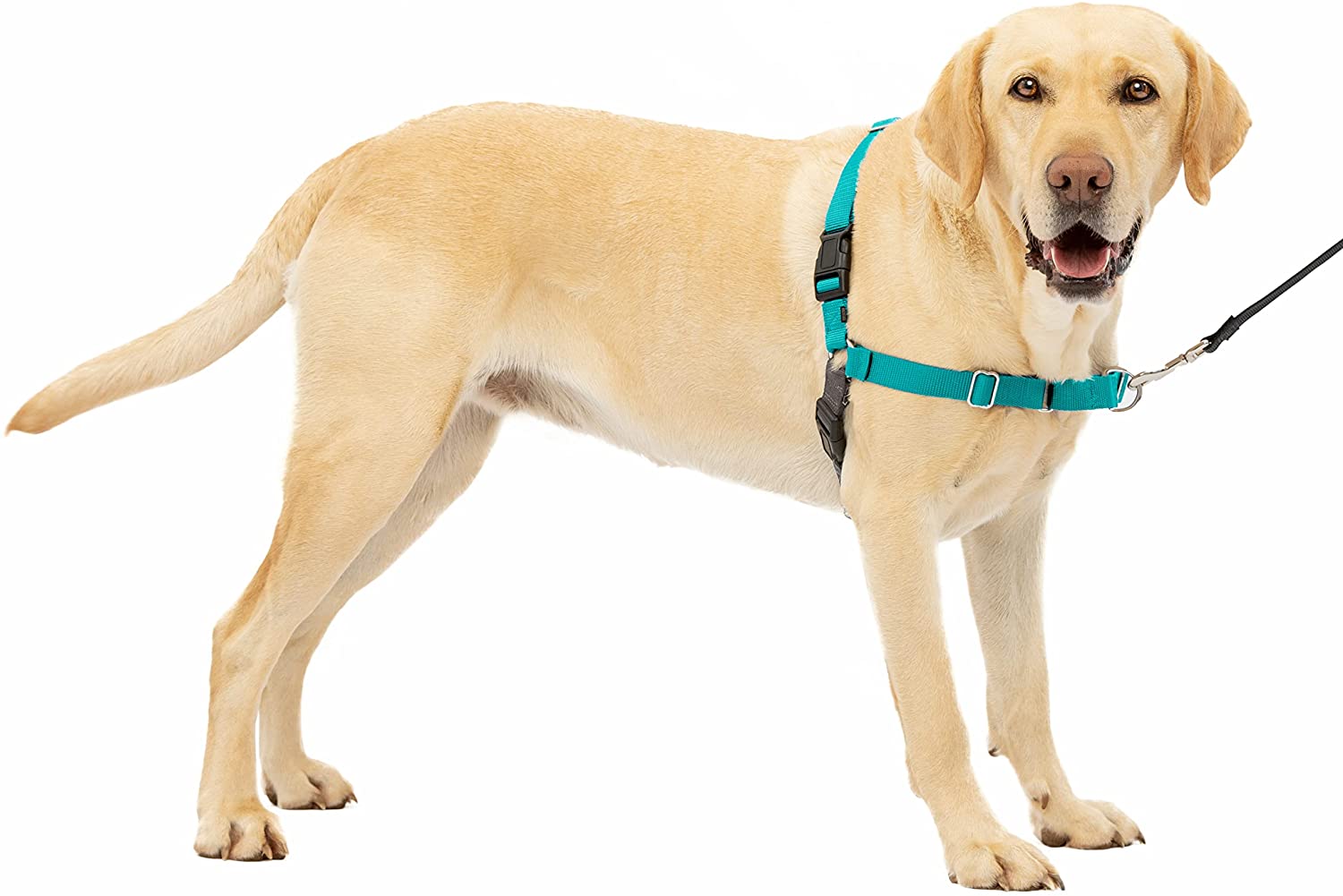
Ruffwear Webmaster Harness for Great Danes
In a ‘less-obstructive’ harness such as the Ruffwear Webmaster or Front Range, your dog will have a lot of leverage to pull you around. If you must use a harness for your Great Dane dog, this can be a good option for dogs that don’t pull or lunge.
It’s also very helpful for dogs that may need a little assistance (it has a handle on the back), for example!
With Great Danes, you should be relying on voice control, training, and obedience, not your physical ability to hold your dog back.
If your Great Dane dog pulls, lunges, reacts or is less than obedient, harnesses will be dangerous for you and for others around you!
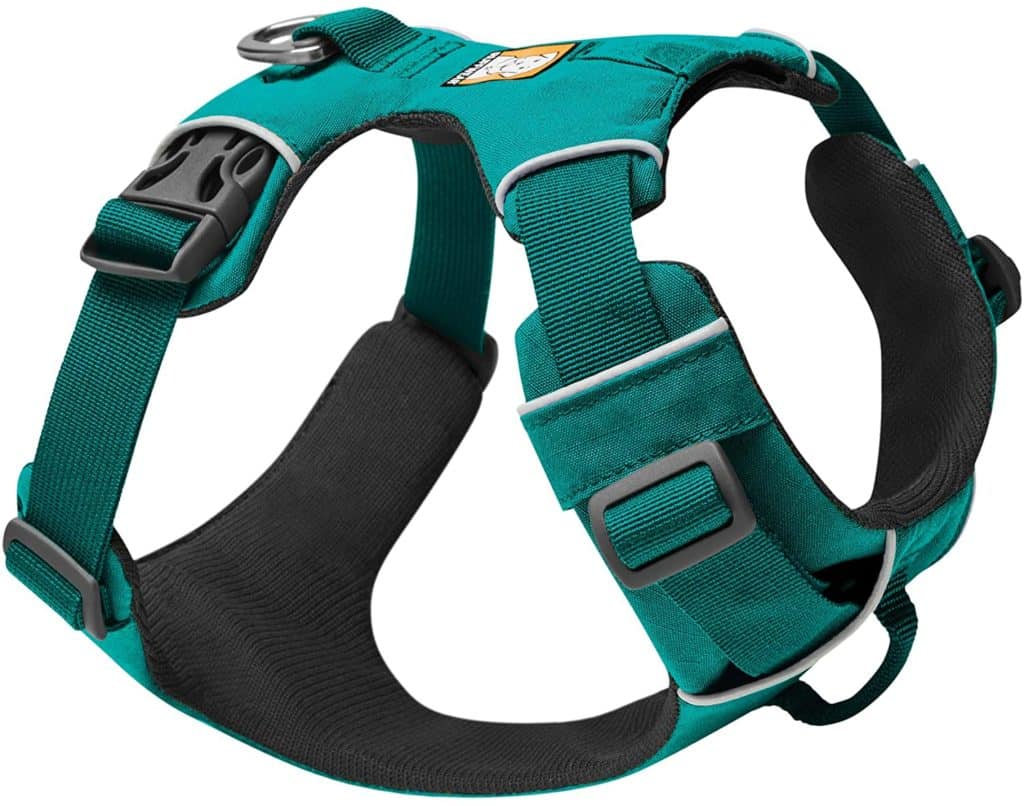
If you must use a harness (some dogs with Wobblers or orthopedic disease that require mobility support and/or that cannot be off-leash, for example) then we recommend the less obstructive Ruffwear harnesses mentioned above.
The Y-front construction of the Webmaster or Front Range or Webmaster harness is less obstructive to movement than harnesses that are made to deter pulling behavior, and the Ruffwear harnesses are well-built! Plus they have a handle on the back if you need to support your Dane for any reason.

The Basic Great Dane Collar
This choice for a regular dog collar is up to your budget and aesthetic needs! There are many options available including collars made of leather, rope, nylon, and Biothane.
A leather collar will be beautiful and there are many custom options available. We love a leather collar on a Great Dane! They look nice and last forever.
A personalized collar with leather stamping or embossing, for example, is an awesome way to make sure your dog has identification without the constant jingling of tags.
This type of ‘basic’ collar is great for everyday use, but still rugged enough to hold up to a Dane:
Biothane Great Dane Dog Collars
Biothane is nice option for people who have dogs that like to play in the mud or swim, as they are waterproof and easy to clean. We like Biothane dog collars because they also come in bright collars and can be customized when you shop for them at www.etsy.com!
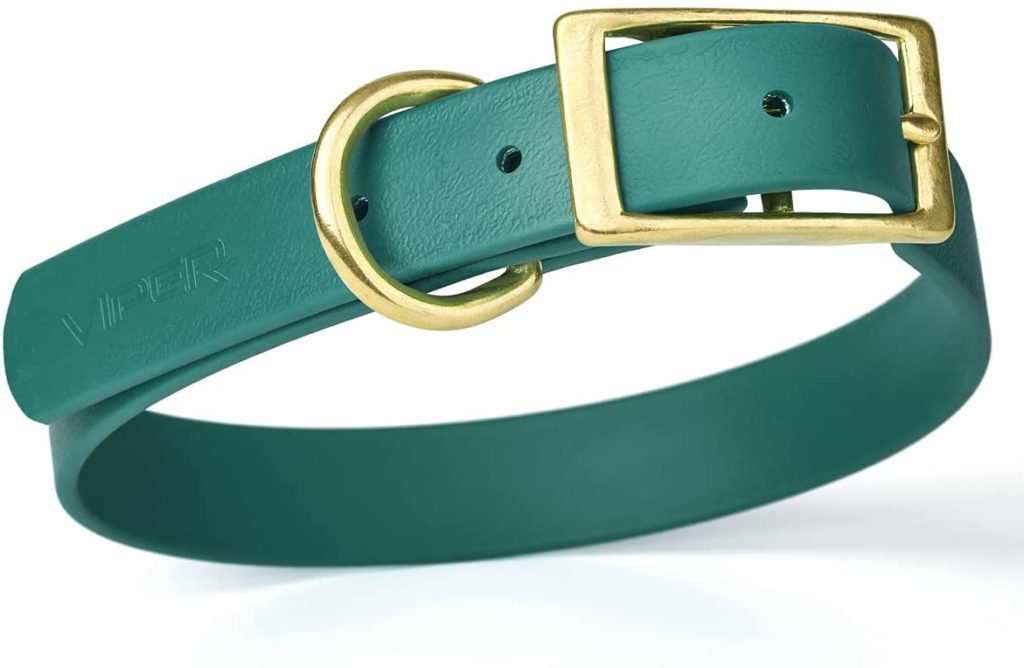
Tactical Dog Collar
Some Great Dane dog owners love the look and rugged construction of a tactical dog collar! These are usually wide, heavy, and made with sturdy hardware that is less likely to break if your dog were to lunge or pull.
Many of them have handles, too and they typically come in camouflage colors such as taupe and green. We love and recommend this type of wide, heavy collar for large, full-grown adult Great Danes.


Great Dane Collar Safety
We don’t recommend leaving collars on dogs unattended, especially if your Great Dane tries to escape their crate, destroy things, get into stuff or play rough with your other house dogs.
Many Great Dane dogs have been hurt or killed by collars that were worn unattended.
If you are worried about your Great Dane running away without a dog collar unattended, we recommend off-leash training, obedience training, a remote electric training collar (more on this below), management, and a microchip!
What size collar does a Great Dane puppy need?
Great Dane puppies do best with small or medium-sized inexpensive nylon dog collars.
Blueberry Pet Collars on Amazon has a massive range of regular collar patterns and colors to choose from. An adjustable Great Dane collar with a range of several inches will last the longest as your puppy experiences explosive growth.
Measure your Great Dane’s neck; most puppies fit into a size small or medium to start.
Keep in mind that your Great Dane puppy is going to grow FAST and you’ll be needing to replace this soon enough, so save your money at this point!
You’ll need your cash reserved for food, supplements, vet care, and regular training collars for your adult Great Dane!
Never leave your Great Dane puppy unattended in a dog collar, training collar, or martingale collar of any type.
They can become trapped, chew it off and try to swallow it or get tangled up while attempting to escape or while playing with other dogs in the house.
The best dog collars for Great Dane Puppies
We recommend choosing a flat collar OR ergonomic harness for your puppy.
Do not introduce any kind of prong-style collars, head collars, ‘no-pull’ harnesses or otherwise until your puppy has a good positive basic obedience foundation and lots of socialization.
If your Great Dane puppy dog pulls, go back to basics! Leash training is 99% YES. Instead of punishing your Great Dane puppy for pulling, teach your puppy what you want them to do instead.
How to leash train a Great Dane Puppy
Use treats praise and fun games to reward your puppy for looking at you, walking next to you, and staying by your side around obstacles.
These are easy to teach in boring places. As your leash training progresses, you might even work with a trainer to build on those skills around distractions such as other dogs.
Use positive socialization methods and a longer leash to explore the world around you and encourage calm behavior.
We recommend that all Great Dane puppies work towards their Canine Good Citizen title! For more information on leash training Great Danes, read our blog post here.

What are the Best Dog Collars for Great Danes that Pull?
Many Great Danes learn quickly that they are bigger, stronger, and faster than you. They have a massive neck size, powerful chests, and shoulders and can really throw their weight around!
We tend to accidentally encourage these dangerous behaviors by using a tense leash and getting frustrated or chasing and scolding our dogs.
A Great Dane that pulls is a dangerous dog, even if they are friendly! For those dogs, a basic dog collar with a cheap leash attachment is unlikely to be enough.
In the next section, we will cover the best Great Dane collars, the best shock collars, and the ideal dog training collars for Great Danes, so that you can make an informed and humane decision for your gentle giant!
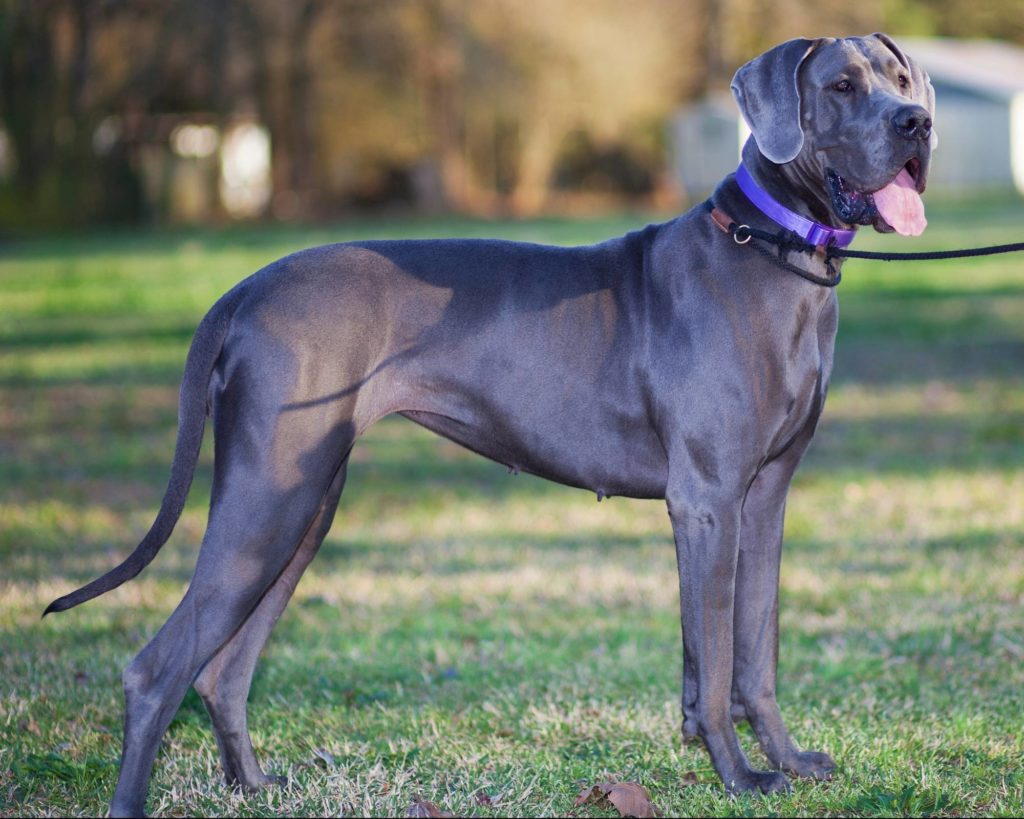
Are no-pull harnesses good for Danes that pull?
No-pull harnesses, also known as ‘Front Clip’ or ‘Easy-Walk’ harnesses are often seen as a positive and friendly alternative for dogs that pull, however, they are not good for Great Danes.
These harnesses punish and attempt to reduce the pulling behavior by restricting natural movement and adding pressure to the chest, ribs, front, armpits, and shoulders.
Many dogs will pull through this pressure anyways because the environment is still more rewarding than the damage they are doing to themselves.
These are also easy to escape and will do little to deter pulling caused by fear, overstimulation, frustration, excitement or anxiety.

A front clip or ‘no-pull’ harness may or may not temper pulling behavior, but it will nearly always alter your dog’s natural gait and ability to freely and comfortably extend the front limbs.
Types of Harnesses you should not use with a Great Dane Dog
We never recommend the use of any kind of ‘no-pull’, front clip, or T-Strap harness for Great Danes!
Why are no-pull harnesses bad for Great Danes?
When worn, they keep your dog from moving naturally and don’t allow the front limbs to extend comfortably or fully, even when your Great Dane is not pulling!
Somehow, these have been marketed as ‘positive’, ‘humane’ and ‘force-free’ however they are definitely not. Even if a harness like this is fit correctly, used with a double leash system or marketed as ‘gentle’, it’s still working by restricting movement.
Great Danes are giant breed dogs with sensitive orthopedic needs. They need to be able to move naturally without having their shoulders restricted. At the same time, you as the owner needs to know that your Great Dane cannot and will not pull you down!
If you regularly have your Great Dane wearing an Easy-Walk, Balance, Freedom, or a similar ‘no-pull’ harness, we recommend switching to a good training collar instead (more information below).
Many dog parents who want to do the right thing for their dogs are surprised by this information, and that’s understandable!
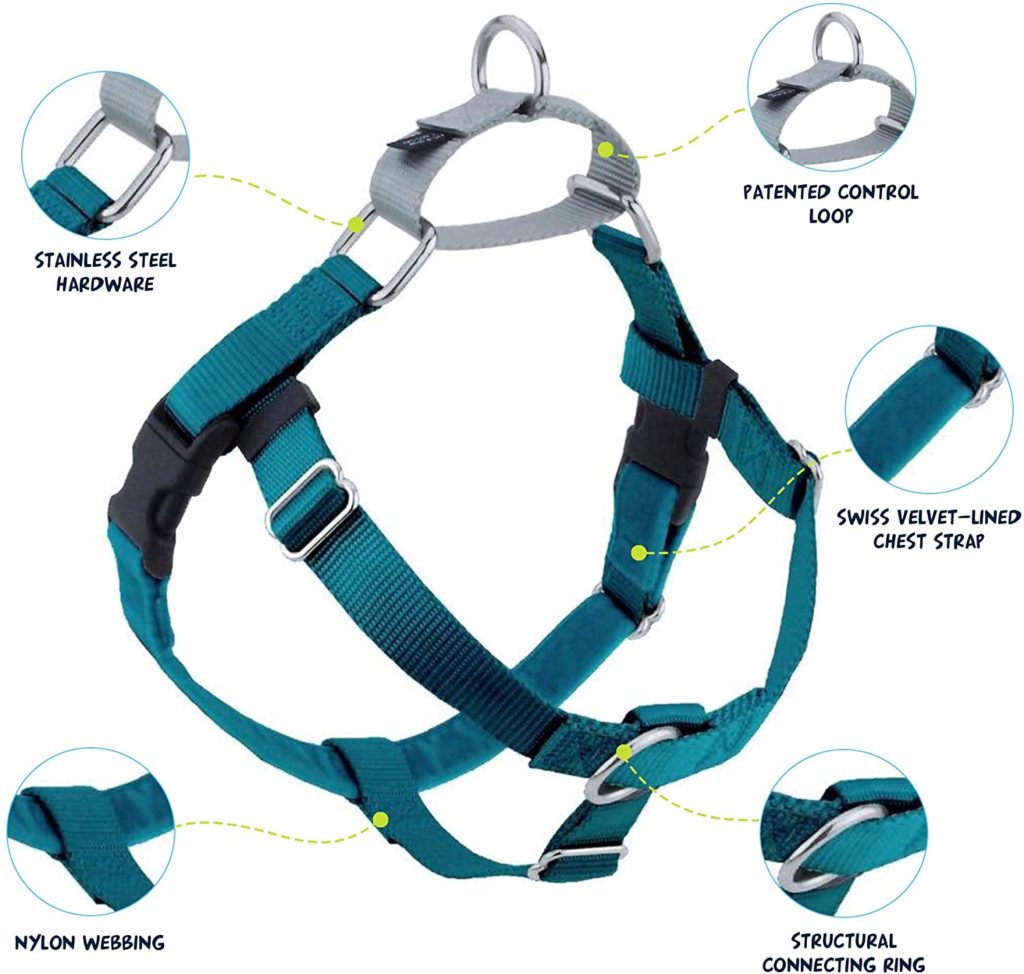
Is a Martingale Collar Good for Great Danes?
A martingale collar is our top choice for walking Danes that don’t pull or lunge!
Martingale collars are escape-proof and the wide fabric version will be gentle and non-obstructive on a Great Dane’s neck.
Martingale collar pro tip: the collar should be made snug enough that if your dog were to pull into the collar or try to back out, the two D-rings would not touch.
Martingale collars should never be worn when your dog isn’t on a walk or being actively supervised.
Do Martingale Collars Hurt Dogs?
Martingale collars are wonderful in that they are not meant to be harsh or punishing, and they are incredibly difficult for a dog’s head to slip out of.
Newly adopted dogs and dogs that are a flight risk should ALWAYS be in a martingale collar or on a slip lead!
They also come in a range of stylish collar options from floral to superheroes, in soft fabrics and wide widths that make them ideal for walking your Great Dane.
A proper martingale collar for a Great Dane dog will be wide, flat, and made of nylon or fabric.

Ruffwear Chain Reaction Martingale Dog Collar
Some models, such as the Ruffwear Chain Reaction dog collar have a metal chainlink paired with nylon that allows you to quickly zip the chain. The noise is an audible correction that will get your dog’s attention.
The chain reaction option is good for dogs that only gently pull occasionally or need a little reminder to focus at times, but will not be good or safe for dogs that pull wildly.
Those dogs need to be in a Herm Sprenger prong collar (more on this below).
Martingale collars are different than choke collars: choke collars have nothing stopping them from becoming extremely tight and restrictive. Martingale collars are ‘limited slip’ and will stop becoming tighter at a certain point.
Martingale collars are not meant not hurt your dog, but as with any training collar, if your dog is lunging, pulling, and acting as a freight train you should seek professional help.
A dog in that state of mind is a danger to you and to itself.

Does a Gentle Leader Work for Great Danes?
Like the no-pull harness, head collars (also known as ‘Gentle Leaders’ and ‘Halti’ collars) are promoted as a ‘positive’ and ‘humane’ alternative to prong collars for Great Dane dogs.
Is the Gentle Leader an Abusive Tool?
Things that are More Aversive Than an E Collar in Training
EZ 900 Collar Review
They are somewhat effective at reducing or eliminating pulling in Great Danes because they are so aversive and punishing!
The solid majority of Great Danes require an adjustment period when introduced to head collars. They are uncomfortable to wear.
The reality is that many dogs just don’t like them, even after weeks of positive conditioning!
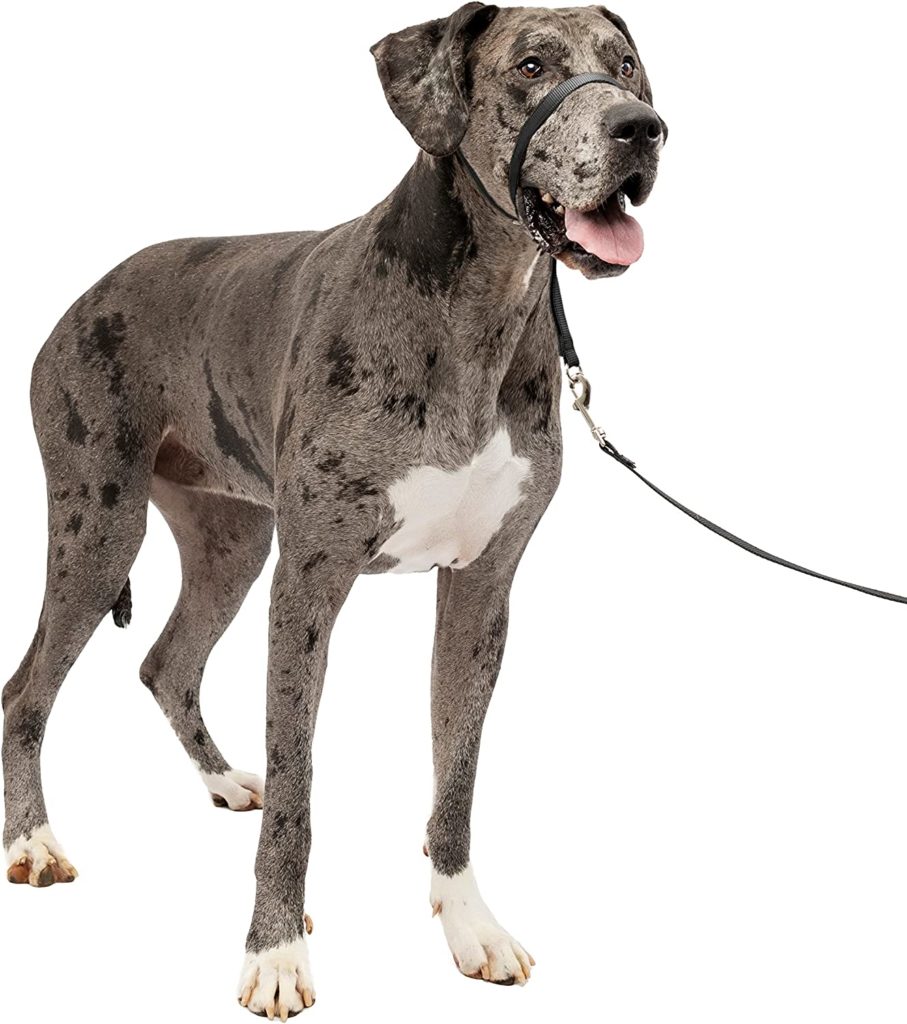
If your Great Dane pulls or lunges in a Gentle Leader (or similar), their head will be forced to the side.
This is fairly effective at deterring pulling and lunging, however, we believe it’s not ideal for their sanity OR their orthopedic health.
Dog lovers everywhere should take note of this before using or recommending this tool.
Gentle Leaders and similar devices are especially problematic for Great Danes that do tend to lunge, pull, react, or are prone to wobblers (which has a genetic link and by the moment of diagnosis, the damage has been done).
Many times, lunging and pulling will also mean that the skin on their face will be rubbed or pushed up into their eyeballs. A dog’s face has thousands of sensitive nerve endings.
Many Great Danes will paw, whine, lay down or frantically try and remove a head collar from their face. This is a strong indication that head collars are an aversive tool.
Head collars are an inappropriate tool for most Great Danes, despite their popularity and widespread use.
We only advocate for head collars when they are being used thoughtfully, with lots of positive conditioning on dogs with good structure and no genetic link to Wobblers disease…that also don’t pull, lunge or react wildly to begin with.
They can be an appropriate and subtle communication tool for people who are relying on their highly trained Great Dane for service work and public access, or who because of age or stature cannot physically manipulate a prong collar and fully physically control a Great Dane otherwise.
There is a time and a place for them, but as the go-to dog collar for Great Dane training? We believe it’s time to flip the script on this one, and give our Great Danes a much more elegant and humane option. (Read on, friends!).
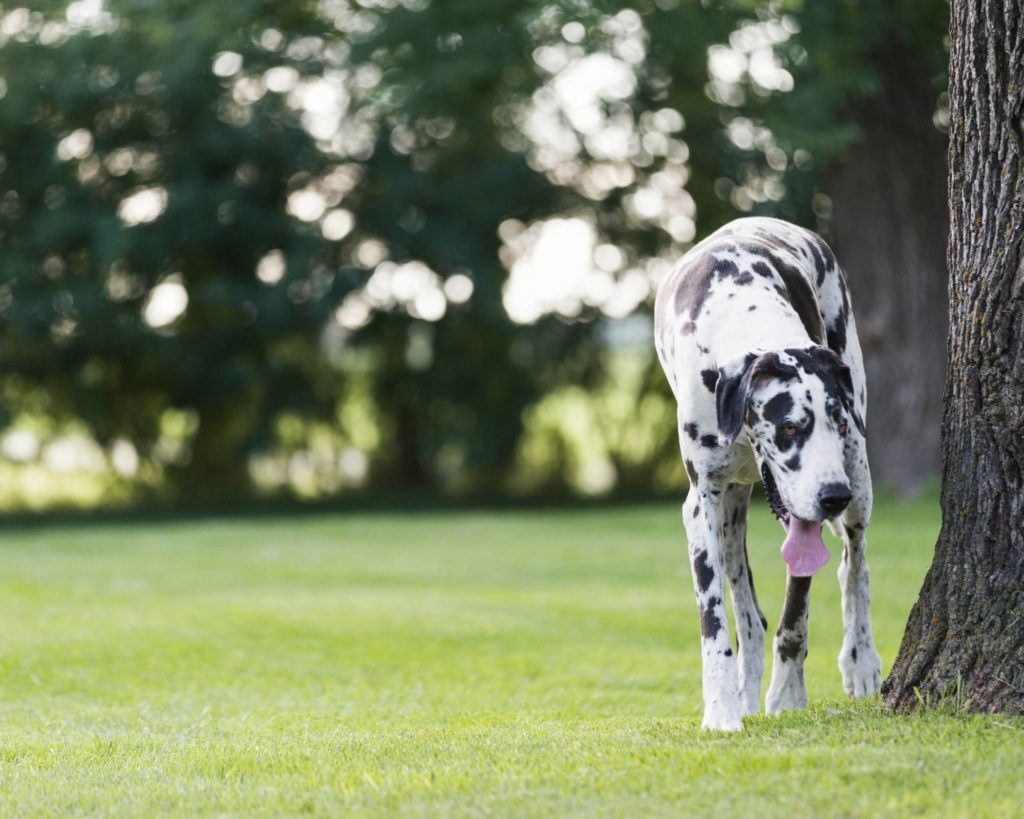
Can You Use a Prong Collar on a Great Dane?
Prong collars are actually one of the most humane, effective and ethical tools to use if you have a Great Dane that lunges or pulls you around.
We hear you, prong collars look like torture devices and you’ve heard some negative propaganda!
However, unlike a nylon harness or Halti Gentle Leader collar, a properly used prong collar relies on a simple YES and NO communication, not physical restraint.
Prong collars provide a clear pressure-based sensation that when paired with positive reinforcement is incredibly effective, gentle and humane at stopping pulling and lunging.
Your Great Dane will then redirect their focus back on you!
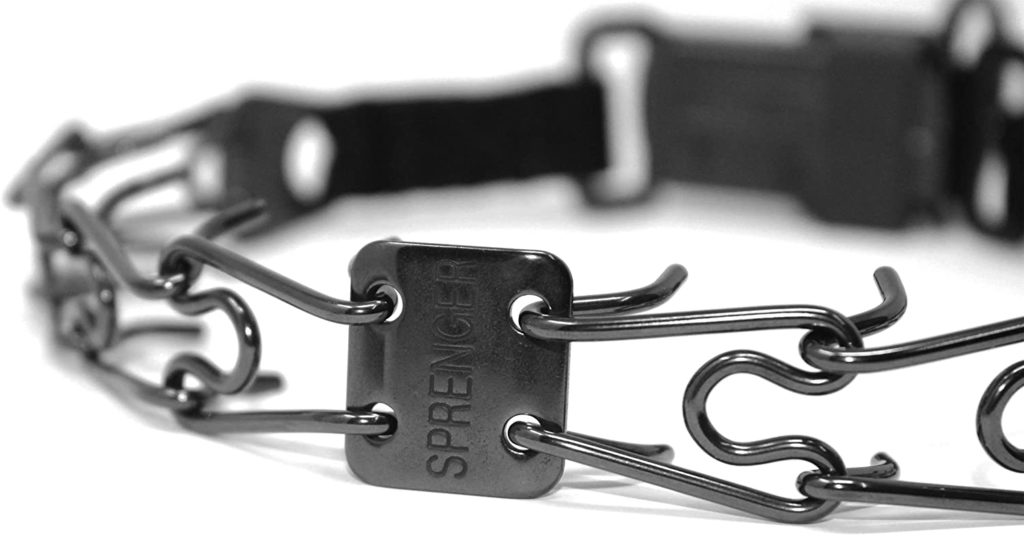
A prong collar is meant to fit snugly on your dog’s neck, high and tight if possible. Loose, poorly fit and poorly made prong collars ARE aversive, so make sure you do it right.
A properly used prong collar will not pop a balloon! They work by causing even pressure around your dog’s neck; this pressure is annoying to your dog but NOT painful and not damaging.
We we only recommend HERM SPRENGER prong collars for dog training, which have blunt ends and construction that protects the trachea and creates pressure, not stabbing.
Cheap prong collars are not made the same and may harm, confuse or frustrate your Great Dane.
Is it cruel to use a prong collar on a dog?
It’s a myth that prong collars are ‘inhumane and rely on pain, stabbing and harsh corrections’.
(We will show you how to introduce a prong collar to a Great Dane in the tutorial below).
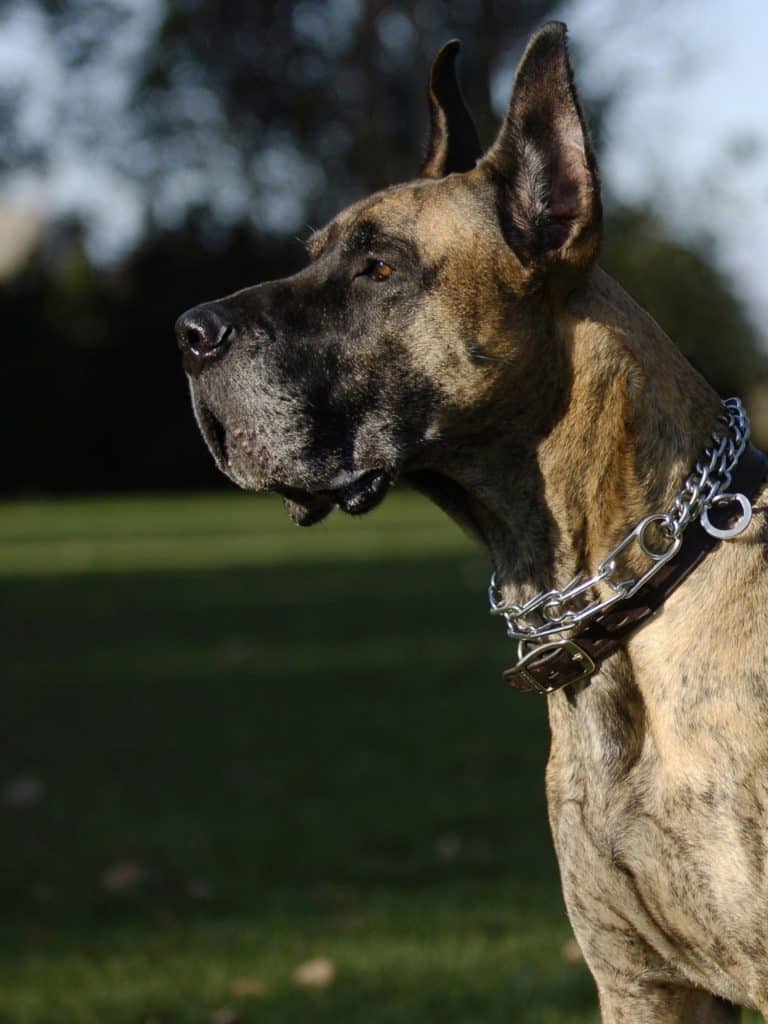
A prong collar is not cruel, but would you like to know what may be?
-Never feeling like you can take your dog places with you because they pull too much on a leash (frustrating to you AND your dog).
-Having your dog become increasingly more frustrated, anxious, bored and under-socialized because you cannot control them in a harness (and people told you that a prong was abuse, so as above you don’t take your dog places).
-Letting your dog jerk themselves around on a collar, harness or head collar because you don’t have a clear, concise way to communicate both YES and NO to your dog.
-Being at your wits end with your dog, unsure what to do, hesitant to consider a prong collar because somebody misled you into believing that it was inhumane and should never be used.
We believe the Herm Sprenger prong collar is one of the best, simplest and most humane Great Dane collars available, however you must learn how to use it correctly!
If your Dane is rubbing their face raw in a head collar and you still think that it’s the more humane choice vs. a prong, read on to learn how the prong collar is actually a very positive tool!
How to use a prong collar on a Great Dane
- Start off-leash in a boring room. Use treats and praise to reward your dog for standing at your left side and looking at you.
- Take a step (lure your dog to step with you if needed) and then reward your dog. YES! Treat. Gradually add steps between rewards. Once you can walk 10 steps and have your dog stay by your side for the reward, add the ‘heel’ command.
- Begin walking more than ten steps. Add in turns and obstacles. Keep it positive and fun!
- Fit your Herm Sprenger prong to your dog (High and tight, snug and ideally with a second leash clipped to a backup collar. Add a good leather or nylon leash and hold it loosely in your hand. Do not add tension! Practice walking around in your boring room with the obstacles and turns, and continue to reward your dog. This ongoing practice will give you voice control, which is much more effective and safe than physical restraint.
- Next, allow your dog to sniff around or walk away, or take a step back from your dog until there is tension in the leash. When you feel that tension, plant your feet on the ground (don’t move towards your dog) and continue to apply a little gentle ongoing tension from the leash.
As soon as your dog gives into the pressure and comes towards you, the pressure will release automatically; your dog is in charge of releasing this tension, not you!
You can mark this moment with a YES and reward your dog! Your dog should not yelp, cower, scream or act fearful. Remember, a properly used high quality prong uses pressure, not stabbing.
- Practice step 5 several times in your boring room and then try it outside in low-distraction environments as well! Your dog should learn very quickly that when they feel gentle pressure from the prong, they can make it stop by releasing the tension on the leash and coming to you for guidance. Notice that you are NOT jerking your dog around, popping the collar, allowing your dog to pull wildly, stringing your dog by the neck or being harsh!
- Practice the HEEL position with your dog as above, and continue using ‘pressure and release’ randomly to remind your dog to walk next to you, look at you, or re-engage when distracted. Fade out treats and rely mostly on praise. Remember, KEEP THE LEASH LOOSE! Never add tension unless you are deliberately communicating to your dog. When you do add tension, imagine the tension being so gentle; there is no need to yank or pull back. Gradually increase the distance of your walks and the distraction factor of the environment. Always teach your dog from kindergarten to college: do not expect PHD level obedience at Home Depot out of a dog that is used to pulling wildly and having their way! Work up to that over time.
- When your dog fully understands how their collar works, you can also add quick short ‘pops’ of the prong collar if your dog is not paying attention to you. A quick pop should result in your dog looking at you, at which point you can mark with a YES and a treat! Always reward the behavior that you want.
- With prong collar training the goal is to be as gentle as possible. If you are yanking your dog around, feel like the leash is always tight, have tense hands or are having to constantly correct your dog with ‘pops’, you haven’t set your dog up to understand their collar or how to respond to it. Go back to step one.
- If your dog is ‘leash reactive’ and acts like a fool on a leash, the prong collar will not be a quick fix. As with any tool (including harnesses) you can make this behavior worse if you are relying on the tool only as a ‘punishment’ or physical restraint device. Make sure to use lots of positive reinforcement and set your dog up for success by maximizing the distance between your dog and things that set them off. You can gradually close this gap as your Great Dane becomes more comfortable with their prong collar and relationship with you.
Are Shock Collars Humane?
The shock collar is another greatly misunderstood tool.
Did you know that there is a huge difference between a bark collar, a shock collar and a remote dog training collar (also known as the e-collar)?
E Collar Myths
What is an E Collar?
What is the Difference Between an E Collar and a Shock Collar?
9 Reasons to E Collar Train Your Great Dane Puppy
EZ 900 REVIEW
Should I Use a Bark Collar on a Great Dane?
Bark collars are an automated device meant to deter or stop nuisance barking. They use sound, noxious smells (such as citronella), shock or uncomfortable levels of muscle stimulation to reduce barking.
Some offer multiple training modes, but in general a bark collar is meant to be a fairly basic, easy to use automated tool.
Bark collars have their place, but it’s important to remember that if your dog barks there is often a reason. Boredom, anxiety, frustration and habit are common causes that should be addressed before using any kind of bark collar!
For more information about using a bark collar on Great Danes, read our article here!
Training Shock Collars for Great Danes
A training shock collar will be inexpensive and offer three training modes: beep, vibrate and a few levels of aversive shocks. The shock is meant to punish and reduce behavior.
We do not recommend the use of inexpensive shock collar devices on Great Danes or other large breed dogs!
The other two training modes (vibrate and beep) are more gentle than the sharp static zap of the shock collar, so many people rely on those modes when training their Great Dane dog.
Remote dog training collars (also known as ‘E-Collars’ or ‘Educator Collars’), on the other hand, are not they same. Far away from a traditional old-school shock collar, they are an excellent choice for Great Danes.
Educator Remote Collars work differently than shock and rely on a wildly effective positive training and conditioning process.
Are E-Collars Good for Great Danes?
Many people who do not understand these more modern devices will tell you that all electric training collars all use aversive shock and that you will harm and abuse your dog by using one.
Many people are uneducated about modern remote collar tools and have never used them or felt the stimulation from a proper one themselves, so take negative opinions with a grain of salt!
(We will elaborate more on this below!)
Do shock collars work on Great Danes?
Of course, shock is very good at deterring behavior. That’s why it works; it’s easy to wave a remote at a dog and scare them away from repeating a behavior.
When you have a giant breed dog, obedience is extremely important for their safety and yours!
A more appropriate choice than a shock collar is to use an Educator Remote dog collar properly to teach your Great Dane dog to come enthusiastically towards you, not run away.
This is very helpful when you want them to stop doing something they shouldn’t be doing, or run to you when something dangerous could harm them.
This is why we advocate for the proper use of modern E-Collars (proactive training), not shock collars (reactive training).

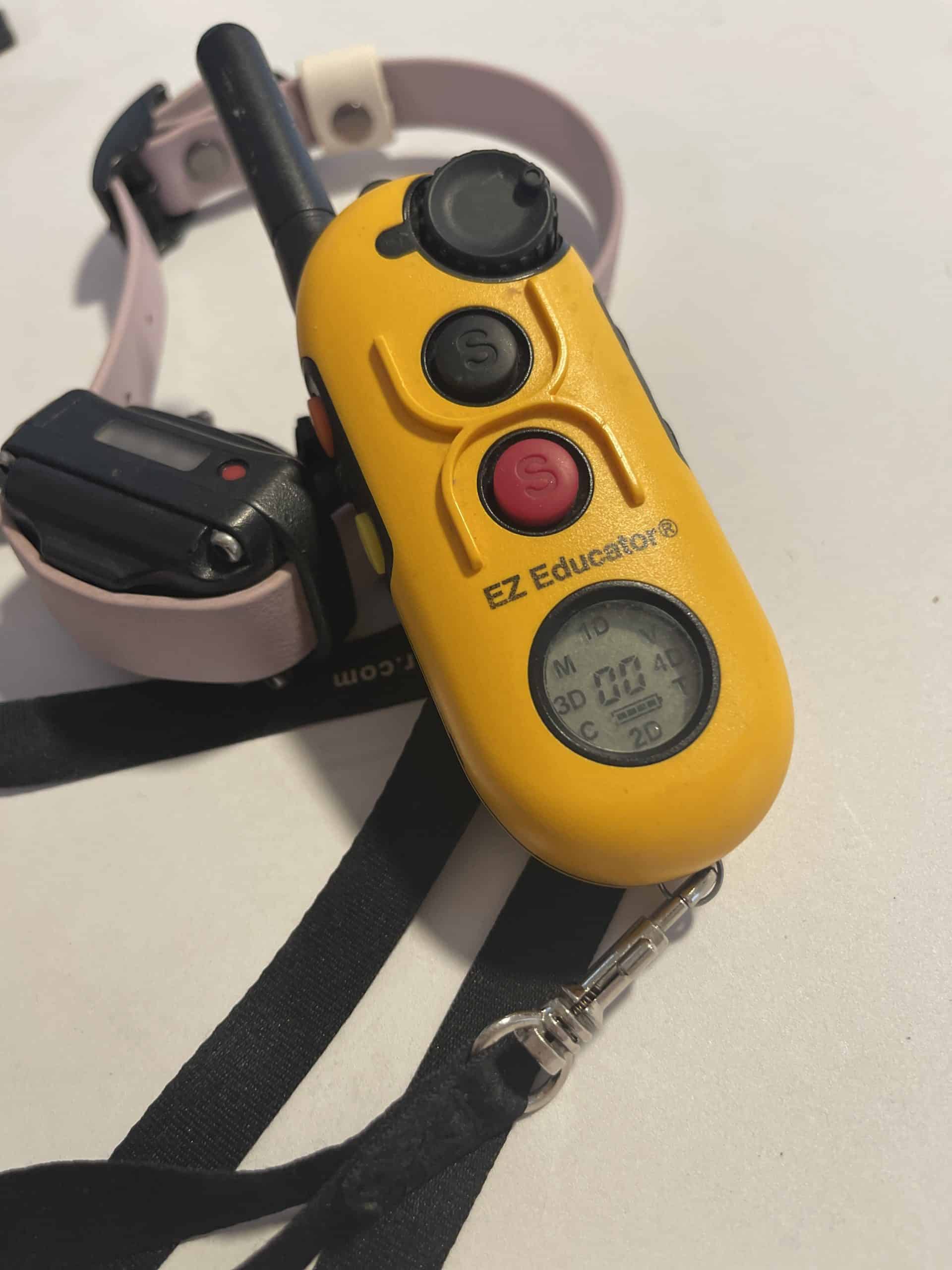
How do E-Collars work?
A modern electronic training collar uses low levels of gentle muscle stimulation that will feel like a touch sensation, not harsh shock or aversive vibration. Following some quick, fun training exercises dogs learn to respond to this stimulation.
The best part about a modern electric stimulation collar is that it relies on communication, not physical restraint!
This is the best and most humane thing for our dogs.
E-Collar trained dogs:
- Come when called, reliably
- Will happily walk away from something when asked
- Can be taught to walk off-leash or in a loose leash position
- Are under voice control, not physical restraint, which is much safer and better for their orthopedic health
- Are kept safe: a dog that has excellent recall and off-leash obedience is not running away, bolting out of the door or jumping over fences
- Have more enrichment: an off-leash trained dog will always have better access to natural physical and mental activities such as swimming, running up and down hills, zooming around, climbing, playing and circling than an on-leash, long-leashed or yard-only dog.
- Cannot damage their gait, neck or shoulders as they can in choke collars, flat collars, harnesses and head collars.
Training your dog with an E-Collar means FREEDOM.
Other dog collars cannot offer any of what we listed above. The modern E-Collar is an elegant, gentle and effective tool.
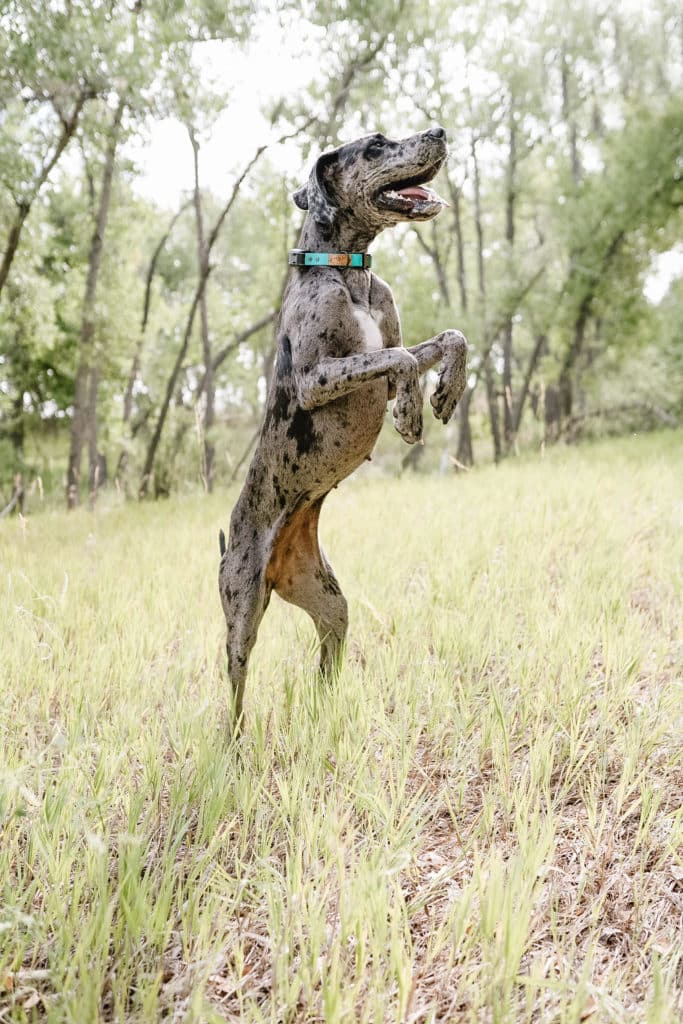
A life changing Great Dane training tool
Many people have told us that our positive E-Collar training method, paired with an Educator collar changed their lives!
We are hearing from Great Dane dog owners who are quickly seeing more freedom, more fun, less frustration, less anxiety and a better relationship between them and their dog.
If you are looking for the best training collar for a Great Dane, we believe that Educator Collars and the positive remote collar training method is key.
The Easy Educator and the Mini-Educator are the best training collars for Great Danes and large breed dogs. They are rugged, waterproof, have a fantastic battery life, and offer 100 levels of stimulation that at low levels cannot be felt by humans.
If you are looking for the best shock collar for your Great Dane, start looking for remote Educator collars instead. We promise it will be worth the extra investment and a little time spent on dog training!
OUR 10 FAVORITE GREAT DANE COLLARS
Mini-Educator
This is the most economical and user-friendly option for modern remote off-leash training.

Easy-Educator
Choose this option if you want more features and have a slightly bigger budget for choosing the best remote single or multi dog system for your Great Dane.
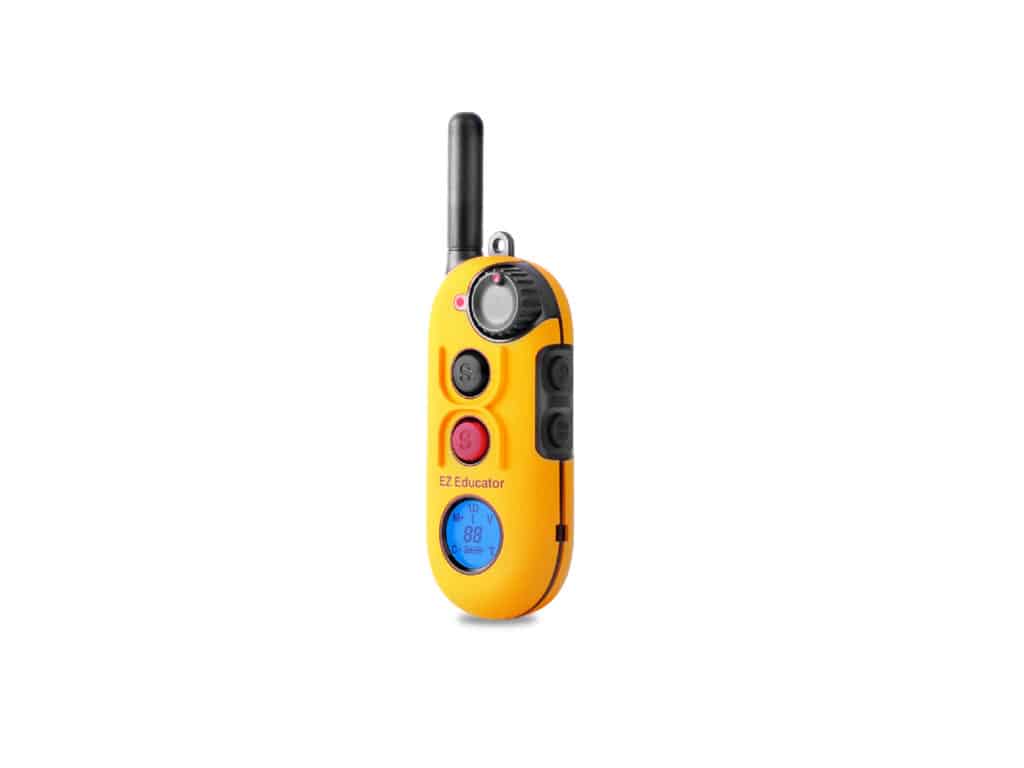
Biothane Bungee Educator Collar
All Educator receivers (the part that your dog wears) should be paired with a bungee collar made of Biothane. The bungee makes it comfortable for your Great Dane to wear the electric dog collar and ensures a good fit!
A collar like this will NOT have a leash attachment, as its meant to be worn on its own.
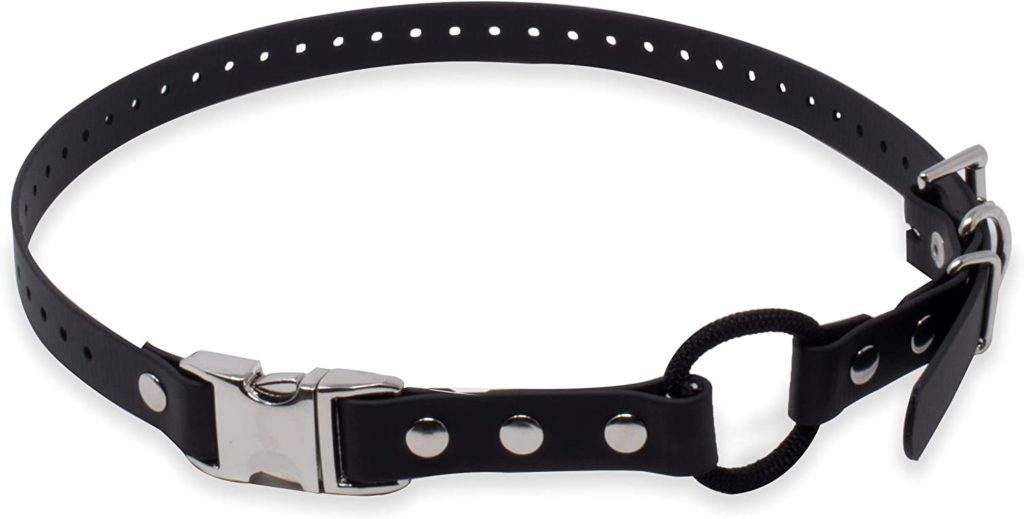
Herm Sprenger Prong Collar
As above, we believe the Herm Sprenger Prong collar is the most effective, humane and gentle option for Great Dane dogs that pull, lunge and struggle to focus. A properly used prong is one of the safest and most gentle Great Dane collars you can choose! Work with your dog using positive reinforcement and plan to fade this one out over time.

Magnolia Mutts Custom Fabric Martingale Collar
We love Magnolia Mutts because she donates a large portion of her income each month to Great Dane rescues! She makes beautiful Martingale dog collars for Great Danes that are fashionable and well-made.
We believe that a Magnolia Mutts martingale collar is one of the best Great Dane collars available for dogs that have been trained to not pull or lunge on a leash.
Slip Lead
A slip lead works by fitting snugly on your dog’s neck and making it so that there is no way for them to escape. Slip leads are a MUST have for dogs that will escape a dog collar or harness. They are also so helpful for quick trips!
What is the Best Leash for Great Danes?
Lastly, we recommend keeping slip leads in your car and around the house; you never know when you might need one.
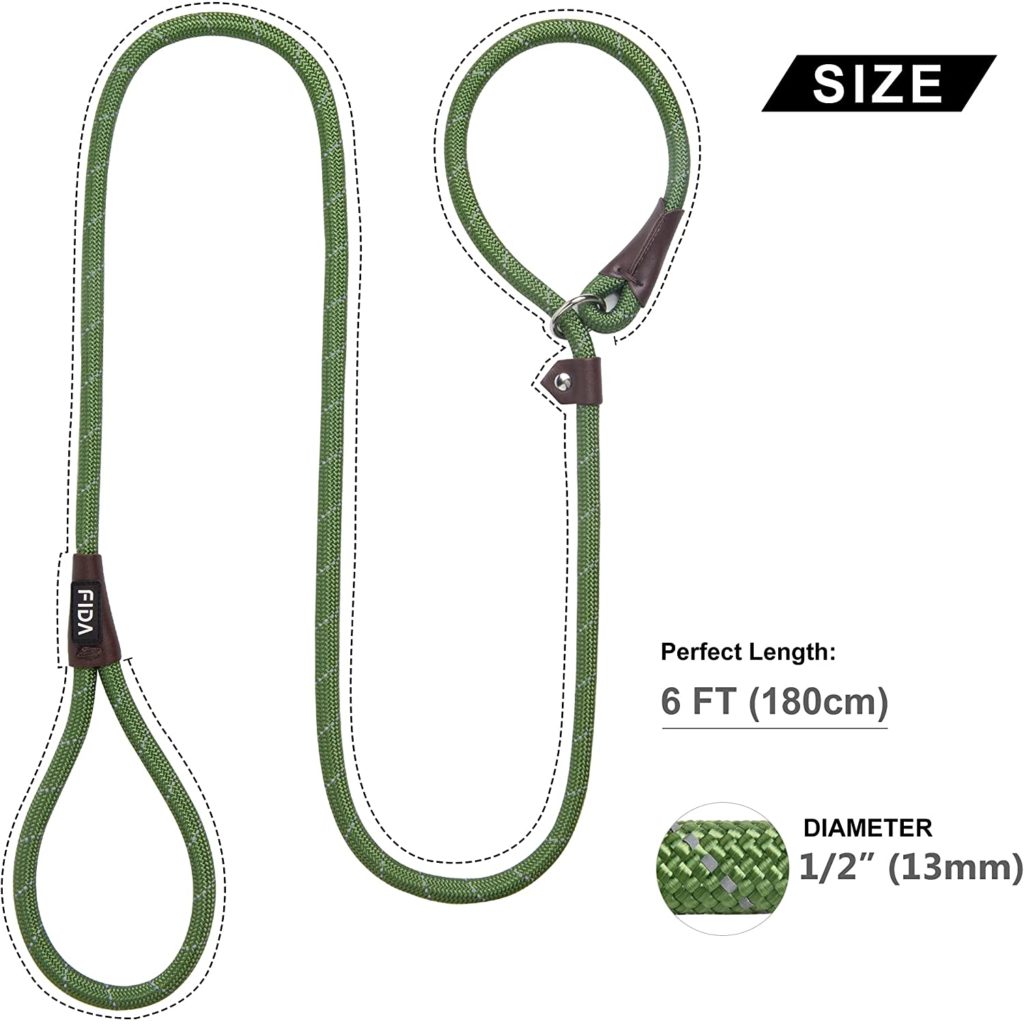
Blueberry Pets Everyday Collar
Blueberry Pets on Amazon has lots of choices in dog collars for your Great Dane. We like this option if you are looking for a good inexpensive and basic regular collar to hold dog tags or wear around the house.
This is a good collar choice for puppies! Choose an inexpensive, adjustable collar that will fit your Great Dane’s neck size as they grow, and that has a leash attachment for those early socialization experiences and leash training exercises.
Blueberry Pets offers different collars to catch the eye of many different dog parents.

Stylish Leather Collar
A leather collar is a rugged, beautiful dog collar for your Great Dane!
The great thing about a leather collar is that it is bound to last. They are tough and tend to wear well with age. Choose this for dogs that don’t pull, when you want something more rugged and more stylish than a basic nylon collar!

Custom Biothane Collar
Biothane is an amazing material that is stink-proof and comes in beautiful colors. Choose this to hold tags on dogs that like to get muddy!
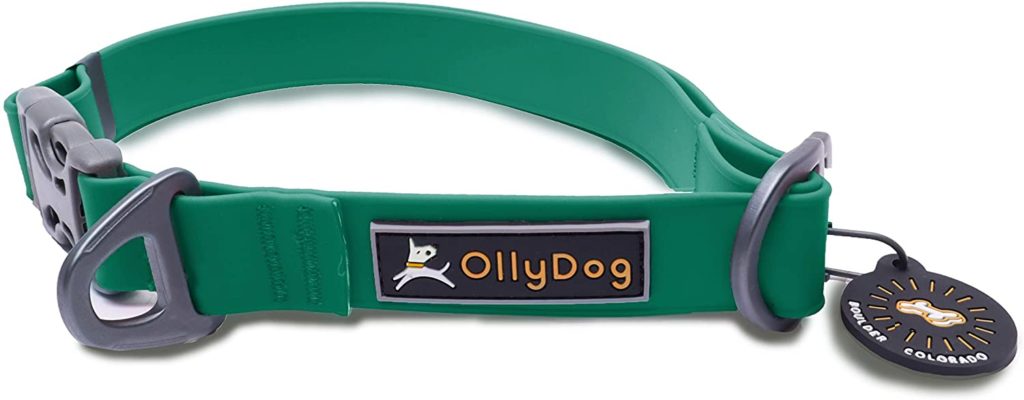
Tactical Collar
Tactical collars look cool and they are rugged enough to hold up to our giant breed dogs. Choose this for walking dogs that DON’T pull.

Ruffwear Chain Reaction
The Ruffwear Chain Reaction is a dog training collar for dog owners that need a little extra control than they get from a martingale or basic flat collar.
It’s a mid-option between martingale and prong dog collars that will help your Great Dane dog understand that they need to focus on you.

HOW TO CHOOSE A GREAT DANE COLLAR
When you are looking for the perfect collar for your Great Dane dog, we hope to have been helpful.
We have covered everything from the best collar material, the best dog collar for puppies, how to choose a waterproof dog training collar, the best Great Dane collars for adult dogs that pull, and shock collar training (including information about the best shock collar options for your pet).
Need more? Join our Facebook group, below!
READ MORE:

JOIN OUR COMMUNITY
Do you like modern positive+balanced off-leash dog training, science-based information, life with Danes, educated ownership and chatting with other like-minded people?
Join our growing Facebook group!
